Week 1: August 1-7, 2013
|
|
| THIS WEEK | THIS FALL | 2013 TOTAL | SITE TOTAL | |
|---|---|---|---|---|
| # birds (and species) banded | 300 (41) | 300 (41) | 1595 (80) | 43107 (113) |
| # birds (and species) repeat | 67 (16) | 67 (16) | 397 (40) | 8378 (70) |
| # birds (and species) return | 7 (5) | 7 (5) | 162 (29) | 1371 (38) |
| # species observed | 84 | 84 | 153 | 208 |
| # net hours | 560.0 | 560.0 | 3916.8 | 73206.5 |
| # birds banded / 100 net hours | 53.4 | 53.4 | 40.7 | 58.9 |
Note: table does not include nocturnal banding (owls)
Banders-in-charge: Simon Duval, Gay Gruner
Assistants: Nicolas Bernier, Marie-France Boudreault, Rui de Jesus, Jean Demers, Jo-Annie Gagnon, Nathalie Gendron, Alison Hackney, Lisa Keelty, Barbara MacDuff, Charlotte Payette, Catherine Russell, Joanne Ryan, Clémence Soulard, Elise Titman, Rodger Titman
Notes: Fall migration is off to another great start! While it seems like mid-summer to most people, the birds know otherwise. Remarkably, for a fourth year in a row we set a new record for the number of birds banded in the first week of August, with an even 300 – a modest jump from last year’s 281, and a fair bit above the 257 in 2011 and 250 in 2010. A good number of them also stuck around for at least a couple of days, with the 67 repeats this week a substantial jump from the previous record of 50. As per tradition, the first day was the busiest, with 70 birds banded. However, it was quite busy most of the week, with between 39 and 55 daily except for a bit of a lull on August 5 with just 21 new birds that day – but that provided a good opportunity for the crew to do some much needed site maintenance (and to spot a Cooper’s Hawk carrying prey toward the Arboretum). There was a lot of variety too, with 41 species banded this week – two more than the previous high for week 1. Even more surprisingly, the 84 species observed this week was a new record by 9, providing ample evidence that migration is well underway already. New observations for the year were Black-crowned Night Heron, Spotted Sandpiper, and Bank Swallow.
|
|
Moult migration is a phenomenon that is relatively poorly documented in eastern North America, but which is quite evident at MBO each fall. These are birds that breed somewhere to the north (presumably) and settle at MBO during their moult, which is often a period of 3-4 weeks, but with some stopovers lasting more than a full month. Tennessee Warblers and Swainson’s Thrushes are the most prominent examples, but others that we hve recorded here include Nashville Warbler and Northern Parula. Among the birds banded on August 6 this week was an adult male Northern Parula already replacing its five innermost primaries, so we expect there is a good chance this bird will hang around until its moult is completed, and hopefully we will capture it at least once more to confirm it as a stopover and document the rate of its moult.
| # individuals banded | mean # individuals observed daily |
|---|---|
| 1. Song Sparrow (96) [1] | 1. Cedar Waxwing (37) [3] |
| 2. Cedar Waxwing (56) [5] | 2. Song Sparrow (35) [6] |
| 3.Yellow Warbler (19) [2] | 3. American Robin (29) [4] |
| 4. Gray Catbird (13) [8] | 4. American Crow (21) [1] |
| 5. American Redstart (10) [4] | 5. American Goldfinch (18) [2] |
| 6. Red-eyed Vireo (9) [5] | 6. Black-capped Chickadee (16)[5] |
| 7. Black-capped Chickadee (8) [8] | 7. Blue Jay (10) [-] |
| 7. Common Yellowthroat (8) [3] | 8. Common Grackle (9) [10] |
| 7. Rose-breasted Grosbeak (8)[-] | 9. Gray Catbird (7) [-] |
| 10. Downy Woodpecker (6) [-] 10. American Robin (6) [-] 10. Swamp Sparrow (6) [-] |
10. Red-winged Blackbird (7) [7] |
We thought that Song Sparrows were dominant in 2006 when we banded 112 of them over the first two weeks of the season, but that year we had just 34 in the first week, and our previous week 1 record was 57 in 2007 … so with 96 this week, we are very curious to see what next week (and the rest of the season) will bring for this species. Equally impressive were the 56 Cedar Waxwings this week – especially since the previous record for a full fall season was 45 in 2011. Yellow Warblers are often numerous early in the season, and like in every one of our eight previous Fall Migration Monitoring Programs, they made it into the top three for the first week of the season. Rounding out the top five, Gray Catbird and American Redstart were both more numerous than usual for this time of year, although the redstarts seem to be getting somewhat earlier and more abundant with almost every passing year. Other highlights in the top ten included a good number of Downy Woodpeckers (likely local offspring) and Rose-breasted Grosbeaks.
The dominance of Cedar Waxwings and Song Sparrows in the nets was matched this week by their overall numbers on site – they took the top two spots on both lists, although swapping places. The mean daily count of waxwings in week 1 has ranged between 13 and 25 in most years, and never higher, so the jump to 37 this week was a pleasant surprise. The rest of the top six included the usual dominant species for early fall – American Crow, Black-capped Chickadee, American Robin, and American Goldfinch. As usual, Common Grackle and Red-winged Blackbird were common enough to crack the top ten, but have not yet formed into large flocks. Blue Jay and Gray Catbird also made it into the top ten this year, the only differences from last year at this time, when the remaining two species were warblers – Yellow Warbler and Common Yellowthroat.
|
|
Our ninth fall season has just begun! We have another 12 exciting weeks ahead, and look forward to sharing our results as the season progresses. Be sure to also check out our Facebook page for live updates and additional photo highlights throughout the season.
|
|
Week 2: August 8-14, 2013
|
|
| THIS WEEK | THIS FALL | 2013 TOTAL | SITE TOTAL | |
|---|---|---|---|---|
| # birds (and species) banded | 160 (30) | 460 (45) | 1755 (81) | 43267 (113) |
| # birds (and species) repeat | 63 (22) | 130 (25) | 460 (45) | 8441 (70) |
| # birds (and species) return | 8 (5) | 15 (8) | 170 (30) | 1379 (38) |
| # species observed | 75 | 95 | 154 | 208 |
| # net hours | 490.0 | 1050.0 | 4406.8 | 73696.5 |
| # birds banded / 100 net hours | 30.6 | 42.9 | 39.8 | 58.7 |
Note: table does not include nocturnal banding (owls)
Banders-in-charge: Simon Duval, Gay Gruner
Assistants: Nicolas Bernier, Sue Bishop, Marie-France Boudreault, Rui de Jesus, Adam Feller, Marianne Gagnon, Marcel Gahbauer, Nathalie Gendron, Alison Hackney, Lisa Keelty, Barbara MacDuff, Benoit Piquette, Jean Rogez, Ahmad Shah, Patricia Stotland, Elise Titman, Rodger Titman, Carine Touma
IMPORTANT: MBO has been selected as one of five finalists in the Jamieson Vitamins “Call for the Wild” contest for 2013. To support MBO, all you need to do is vote daily between August 19 and September 15 by visiting the contest Facebook page (no login required). Four other organizations are competing for their share of $100,000, and the amount allocated to MBO will be entirely dependent on the number of votes received. Please help us succeed with this important fundraiser by voting for MBO every day!
Notes: As has been the case most years, migration seemed to taper off a bit in week 2 after a strong start to the season in week 1. Even though the number of birds banded in week 2 was barely more than half of what we had in the first week of the season, the cumulative total of 460 is the second-best start to fall in 9 years, behind only last year’s record pace. The number of species observed this year dropped to 75, with between 30 and 46 daily. However, the total of 95 so far is the highest ever over the first two weeks of fall – a reflection of both the number of species present, and the dedicated efforts of our many observers to ensure that we document all the species in the area, not just those that we band. The 11 species observed for the first time this season were Sharp-shinned Hawk, Red-shouldered Hawk, Merlin, Solitary Sandpiper, Greater Yellowlegs, Chimney Swift, Eastern Wood-Pewee, Northern Rough-winged Swallow, Barn Swallow, Mourning Warbler (actually the first of 2013), and Canada Warbler. The two warblers were also banded for the first time this fall, as were Great Crested Flycatcher and Warbling Vireo.
|
|
| # individuals banded | mean # individuals observed daily |
|---|---|
| 1. Song Sparrow (33) [1] | 1. Cedar Waxwing (30) [1] |
| 2. American Redstart (22) [5] | 2. Song Sparrow (22) [2] |
| 3.Cedar Waxwing (10) [2] | 3. Black-capped Chickadee (20) [6] |
| 4. Black-capped Chickadee (9) [7] | 4. American Goldfinch (18) [5] |
| 4. Common Yellowthroat (9) [7] | 5. American Robin (14) [3] |
| 6. Ovenbird (8) [-] | 6. American Crow (13)[4] |
| 7. Traill’s Flycatcher (7) [-] | 7. Blue Jay (7) [7] |
| 7. Red-eyed Vireo (7) [6] | 7. American Redstart (7) [-] |
| 7. Rose-breasted Grosbeak (7)[7] | 9. Northern Cardinal (7) [-] |
| 10. Canada Warbler (5) [-] | 10. Gray Catbird (5) [9] |
The impressive start to the season continues for Song Sparrow, with another 33 banded this week for a season total to date of 129, ahead of the previous high of 112 over the first two weeks of fall 2006, and nearly double the average of 67 during this period. Conversely, the 10 American Redstarts banded last week was the slowest start to fall for that species since 2008, but it jumped up to second place this week with more typical numbers. Cedar Waxwing tapered off this week with just 10 more individuals banded. For the second week in a row we banded equal numbers of Black-capped Chickadees and Common Yellowthroats, with both moving up to a tie for fourth place this week. In both cases, most were juveniles, likely from local breeders. The 8 Ovenbirds banded this week was the highest count ever for week 2, although in the peak of their migration in late August and early September we have banded as many as a dozen in a week. The three-way tie for seventh place included Traill’s Flycatcher, which typically peaks in week 2; last year we banded 14 of them in this week. Canada Warbler numbers were a bit below average last fall, so we hope that their appearance in this week’s top ten is an encouraging sign that will carry on into week 3, which on average has coincided with the peak of their fall migration.
Again this week, Cedar Waxwing and Song Sparrow were the species most frequently observed on site. Black-capped Chickadees were more active this week, jumping up to third place, and bumping down the trio of “Americans” (Goldfinch, Robin, and Crow) to occupy the middle of the top ten. After them, there was quite a drop in abundance to the trio of species that averaged 7 individuals per day – Blue Jay, American Redstart, and Northern Cardinal. Although we can be quite certain there are more than 5 Gray Catbirds at MBO presently (breeding pairs plus their offspring), they are perhaps being a bit quiet while the adults moult, and on average we recorded just 5 individuals per day this week.
|
|
Migration was relatively slow over the second half of week two, but that is part of the lull we commonly see between the first wave of early migrants and the next group of species to move south through MBO. We look forward to welcoming other species back to the area in week 3 and sharing them in next week’s report.
|
|
Week 3: August 15-21, 2013
|
|
| THIS WEEK | THIS FALL | 2013 TOTAL | SITE TOTAL | |
|---|---|---|---|---|
| # birds (and species) banded | 170 (34) | 630 (48) | 1925 (82) | 43437 (113) |
| # birds (and species) repeat | 48 (17) | 178 (28) | 508 (47) | 8489 (70) |
| # birds (and species) return | 4 (4) | 19 (10) | 174 (30) | 1383 (38) |
| # species observed | 95 | 107 | 157 | 208 |
| # net hours | 560.0 | 1610.0 | 4966.8 | 74256.5 |
| # birds banded / 100 net hours | 30.4 | 39.1 | 38.8 | 58.5 |
Note: table does not include nocturnal banding (owls)
Banders-in-charge: Simon Duval, Gay Gruner
Assistants: Nicolas Bernier, Sue Bishop, Cindy Bouchard, Kim Bouchard, Marie-France Boudreault, Luke Currin, Rui de Jesus, Jean Demers, Barbara Frei, Jo-Annie Gagnon, Marianne Gagnon, Marcel Gahbauer, Nathalie Gendron, Alison Hackney, Leslie Hunt, Lisa Keelty, Ghislaine Laurin, Betsy McFarlane, Benoit Piquette, Catherine Russell, Ahmad Shah, Clémence Soulard, Patricia Stotland, Elise Titman, Rodger Titman
IMPORTANT: MBO has been selected as one of five finalists in the Jamieson Vitamins “Call for the Wild” contest for 2013. To support MBO, all you need to do is vote daily between August 19 and September 15 by visiting the contest Facebook page (no login required). Four other organizations are competing for their share of $100,000, and the amount allocated to MBO will be entirely dependent on the number of votes received. Please help us succeed with this important fundraiser by voting for MBO every day!
Notes: It was a relatively slow but steady week at MBO under sunny skies that allowed for full effort throughout the week. We banded between 15 and 33 birds daily, but diversity was good, with as many as 20 species on the final day of the week. The total of 170 birds banded this week was a bit above the long-term average of 147 for week 3. Observations were even better, with daily species counts ranging from 45 to 57 and a total of 95 for the week, miles ahead of the previous week 3 record of 85 species set just last year, let alone the mean of 78. Not surprisingly, the cumulative total of 107 is also well beyond the previous high of 102, also recorded last year.
|
|
Among the rich variety of species observed this week were a dozen spotted for the first time this fall: Great Egret (in the back pond and the first for 2013), Cackling Goose (flying over, also the first for 2013), American Black Duck (flying over, but previously observed in spring), Olive-sided Flycatcher (hanging out with other flycatchers at Hummingbird Corner, another first for the year), Winter Wren, Golden-crowned Kinglet, Hermit Thrush (presumably a moult migrant), Cape May Warbler, Pine Warbler, Palm Warbler (yellow race), Wilson’s Warbler, and Bobolink. Three of these species (Hermit Thrush, Cape May Warbler, and Wilson’s Warbler) were also banded for the first time this season, and the thrush was the first of its kind banded this year.
| # individuals banded | mean # individuals observed daily |
|---|---|
| 1. American Redstart (29) [2] | 1. Cedar Waxwing (41) [1] |
| 2. Song Sparrow (22) [1] | 2. American Goldfinch (31) [4] |
| 3.Baltimore Oriole (10) [-] | 3. Black-capped Chickadee (21) [3] |
| 4. Tennessee Warbler (8) [-] | 4. Song Sparrow (19) [2] |
| 4. Common Yellowthroat (8) [4] | 5. American Crow (18) [6] |
| 6. Cedar Waxwing (7) [3] | 6. American Robin (15)[5] |
| 6. Canada Warbler (7) [10] | 7. Canada Goose (15) [-] |
| 8.Traill’s Flycatcher (6) [7] | 8. Blue Jay (10) [7] |
| 8. Yellow Warbler (6)[-] | 9. American Redstart (9) [7] |
| 10. Rose-breasted Grosbeak (6) [7] | 10. Ruby-throated Hummingbird (8) [-] 10. Baltimore Oriole (8) [-] |
This week’s banding efforts were again dominated by American Redstarts and Song Sparrows, although they swapped positions from last week’s list. Their prominence is not surprising – this is the fifth time in nine years that American Redstart has topped the list of birds banded in week 3, and it is the fifth time that Song Sparrow has been in the top two. Only in 2012 was a different species leading the way in week 3; that was Common Yellowthroat, which was tied for fourth place this week. It was tied with Tennessee Warbler, which typically peaks in September, and has never before ranked higher than 7th place this early in fall. Slipping into third place was Baltimore Oriole, with the second-highest ever count for week 3 – and a great relief to us, since the first two weeks of August usually represent the peak for this species, and we only banded a single individual over that period this year! Cedar Waxwing numbers continue to taper off, although this week’s 7 individuals raised the season total to 73. Tied for sixth place was Canada Warbler, boosting its fall total to 12 individuals, approaching our long-term average for the season. Traill’s Flycatcher reached the top ten for a second week in a row, but we expect their numbers will soon drop off as they are one of the earliest migrants to leave MBO. Rounding out the top ten, Yellow Warbler bounced back in, although still on pace for a record low fall total, while the steady flow of Rose-breasted Grosbeaks continued.
For a third consecutive week, Cedar Waxwing remained the most abundant species observed. American Goldfinch numbers continue to increase, rising to second place this week. Black-capped Chickadee and Song Sparrow counts were similar to last week, but they got bumped down to third and fourth place by the arrival of more goldfinches. Crows and robins again fit into the middle of the top ten. Canada Goose has historically not cracked the top ten until September – except last year when flocks also began to appear in week 3. It will be interesting to see whether this earlier movement of geese continues in future years. Blue Jays and American Redstarts both increased slightly in numbers this week, but dropped down the rankings compared to last week, reflecting the overall increase in birds in week 3. Two relatively unusual new additions tied for tenth place – Ruby-throated Hummingbird and Baltimore Oriole.
|
|
Already the season is changing perceptibly, with more “mid-fall” migrants like Tennessee, Black-throated Blue, and Wilson’s Warblers arriving. What more new species will arrive next week? Check back for our week 4 report at the end of August!
|
|
Week 4: August 22-28, 2013
|
|
| THIS WEEK | THIS FALL | 2013 TOTAL | SITE TOTAL | |
|---|---|---|---|---|
| # birds (and species) banded | 330 (40) | 960 (54) | 2255 (83) | 43767 (113) |
| # birds (and species) repeat | 80 (21) | 258 (31) | 588 (48) | 8569 (70) |
| # birds (and species) return | 2 (2) | 21 (11) | 176 (31) | 1385 (38) |
| # species observed | 88 | 115 | 158 | 208 |
| # net hours | 539.5 | 2149.5 | 5506.3 | 74796.0 |
| # birds banded / 100 net hours | 61.2 | 44.7 | 41.0 | 58.5 |
Note: table does not include nocturnal banding (owls)
Banders-in-charge: Simon Duval, Gay Gruner
Assistants: Nicolas Bernier, Sue Bishop, Marie-France Boudreault, Carl Bromwich, Luke Currin, Mark Currin, Rui de Jesus, Jean Demers, Jo-Annie Gagnon, Nathalie Gendron, Alison Hackney, Lisa Keelty, Barbara MacDuff, Betsy McFarlane, Catherine Russell, Ahmad Shah, Clémence Soulard, Patricia Stotland, Elise Titman, Rodger Titman, Carine Touma
IMPORTANT: MBO has been selected as one of five finalists in the Jamieson Vitamins “Call for the Wild” contest for 2013. To support MBO, all you need to do is vote daily between August 19 and September 15 by visiting the contest Facebook page (no login required). Four other organizations are competing for their share of $100,000, and the amount allocated to MBO will be entirely dependent on the number of votes received. Please help us succeed with this important fundraiser by voting for MBO every day!
Notes: What a week! Except for an unusually low total of 128 in 2007, the number of birds banded in week 4 has remained relatively similar over the years, otherwise ranging from 166 to 240. After last week’s decidedly average numbers, we certainly were not expecting such a dramatic new week 4 record of 330 individuals! The bulk of the migration (223 of the 330 birds banded) came through over a three day period (Aug 25-27), with between 24 and 31 individuals on each of the four other days this week. The 40 species banded this week was also well above average, although behind the high count of 43 last year. Once again, observations were great throughout the week too, with the 88 species recorded being a big jump from the previous record of 8 Unsurprisingly, the cumulative total of 115 for the season is also still far ahead of any previous year at this time.
|
|
Another 8 species this week were seen for the first time this fall, including Common Nighthawk, which was also new for 2013. The other new arrivals for the season were Common Loon, Red-bellied Woodpecker, Broad-winged Hawk, and a quartet of mid-season warblers – Orange-crowned, Blackburnian, Bay-breasted, and Blackpoll. Three of those warblers were also banded for the first time this fall (no luck with Blackburnian yet), as were Blue jay, Golden-crowned Kinglet, and Yellow-rumped Warbler. The Orange-crowned Warbler was the only species not banded earlier this year in spring or summer.
| # individuals banded | mean # individuals observed daily |
|---|---|
| 1. Tennessee Warbler (73) [4] | 1. Cedar Waxwing (40) [1] |
| 2. Magnolia Warbler (45) [-] | 2. American Goldfinch (39) [2] |
| 3.Common Yellowthroat (19) [4] | 3. Black-capped Chickadee (24) [3] |
| 3. American Redstart (19) [1] | 4. American Robin (14) [6] |
| 5. Northern Waterthrush (17) [-] | 5. American Crow (14) [5] |
| 5. Song Sparrow (17) [2] | 6. Tennessee Warbler (13)[-] |
| 7. Yellow-rumped Warbler (13) [-] | 7. Blue Jay (12) [8] |
| 8.American Goldfinch (12) [-] | 8. Song Sparrow (11) [4] |
| 9. Ovenbird (10)[-] | 9. Common Grackle (10) [-] |
| 9. Cape May Warbler (10) [-] 9. Baltimore Oriole (10) [3] |
10. Magnolia Warbler (9) [-] |
For seven of the previous eight years, Magnolia Warbler has topped the list of species banded in week 4 (the only exception being 2009 when we had only 11 during this week, good for a fifth place tie). They would have easily taken top spot again this year were it not for an unprecedented August wave of Tennessee Warblers. The past two years, we have noticed that the fall flight of Tennessee Warblers has been starting earlier, with 21 of them banded this week in 2012, and 23 in 2011. However, this year, we more than tripled those previous high counts … a pretty good indication of a spruce budworm outbreak to our north, and a safe bet that we are on our way to a record fall season for Tennessee Warbler and perhaps also a couple of the other spruce budworm specialists (e.g. Cape May and Bay-breasted Warblers). Tied for third place were American Redstarts (beginning to taper off a bit) and Common Yellowthroat (on the increase). The sudden spike of Northern Waterthrushes this week was reminiscent of this week in 2006, when we banded 20 of them. Song Sparrow numbers continue to drop a bit more each week, but with a total of 168 over the first four weeks of the season, they still represent nearly 18% of all birds banded this fall. Perhaps the biggest surprise this week was Yellow-rumped Warbler, with 13 individuals banded – the first time ever we have banded more than two of them in a week in August, and in fact we’ve never before hit double digits for a week earlier than mid-September. After hanging around in ever-increasing numbers for a few weeks now, American Goldfinches are finally getting banded in decent numbers too, although clearly most of them are still avoiding the nets. Rounding out this week’s list is a three-way tie with ten individuals each. We banded the same number of Baltimore Orioles last week, but the drop from third place to ninth reflects the overall increase in migration this week. The count of Cape May Warblers is particularly noteworthy, as only once before have we banded more than 10 individuals in an entire season; as with Tennessee Warblers, we can speculate based on these early numbers that we are in for a new record high count this fall.
The top three species observed this week were unchanged from last week, although goldfinches continue to increase in numbers and are nipping at the heels of the waxwings, which have remained pretty steady throughout August. Robins and crows continue to hang out around the middle of the top ten, and are joined by the first wave of Tennessee Warblers in sixth place, and a slight increase in Blue Jays in seventh. Rounding out the list for the week are Song Sparrow (a drop corresponding to the declining number of individuals banded), and new entries from Common Grackle and Magnolia Warbler, both of which are likely to increase in numbers in the coming weeks.
|
|
With 960 birds banded already over the first four weeks of the season, we have a good chance to hit 1000 for August for the first time ever. Combined with the record number of species observed so far this fall, it has been a great start to the season! It’s always risky to make predictions, but we expect the flood of warblers to continue for at least another couple of weeks…
|
|
Week 5: August 29 – September 4, 2013
|
|
| THIS WEEK | THIS FALL | 2013 TOTAL | SITE TOTAL | |
|---|---|---|---|---|
| # birds (and species) banded | 309 (39) | 1269 (60) | 2564 (86) | 44076 (113) |
| # birds (and species) repeat | 61 (15) | 319 (32) | 649 (48) | 8630 (70) |
| # birds (and species) return | 5 (5) | 26 (15) | 181 (34) | 1390 (38) |
| # species observed | 81 | 117 | 158 | 208 |
| # net hours | 526.0 | 2675.5 | 6032.3 | 75322.0 |
| # birds banded / 100 net hours | 58.7 | 47.4 | 42.5 | 58.5 |
Note: table does not include nocturnal banding (owls)
Banders-in-charge: Simon Duval, Gay Gruner
Assistants: Angelika Aleksieva, Cindy Bouchard, Luke Currin, Rui de Jesus, Jo-Annie Gagnon, Nathalie Gendron, Alison Hackney, Frédéric Hareau, Lisa Keelty, Barbara MacDuff, Besty McFarlane, Catherine Russell, Marilou Skelling, Patricia Stotland, Elise Titman, Rodger Titman
IMPORTANT: MBO has been selected as one of five finalists in the Jamieson Vitamins “Call for the Wild” contest for 2013. To support MBO, all you need to do is vote daily between August 19 and September 15 by visiting the contest Facebook page (no login required). Four other organizations are competing for their share of $100,000, and the amount allocated to MBO will be entirely dependent on the number of votes received. Please help us succeed with this important fundraiser by voting for MBO every day!
Notes: Migration remained unusually strong for a second week in a row, with another 309 birds banded over the past seven days. That total was just barely behind the 311 birds banded this week in 2011 – not coincidentally the previous time that we had a big influx of Tennessee Warblers. The movement has been more sustained this year though, with the cumulative total of 1269 birds so far this fall well ahead of the previous record of 1090 set just last year. As was the case last week, numbers peaked on the second last day of the week, with 96 birds banded on September 3; the increase began the day before with 47, but otherwise the daily totals were all between 25 and 39. The diversity of species banded (39) was again well above average, but for the first time this fall the number of species observed for the week fell to below average (although just barely). Although the average number of species observed daily was 45, down only slightly from 47 the week before, the highest daily count was 49, compared to three days in week 4 with counts above 50 (as high as 58 on August 25 – the peak so far this fall). All the same, the 117 species observed to date this fall is still more than in any previous year.
|
|
With so many species observed already in the first four weeks of fall, it’s not surprising that new additions are becoming scarcer. This week only Bald Eagle and Ruby-crowned Kinglet were added. However, for the first six days of the week, we added a new species daily to the list of birds banded this fall – starting with Sharp-shinned Hawk on August 29 (our first of 2013), followed by Blue-headed Vireo, Brown Thrasher, Ruby-crowned Kinglet, Eastern Wood-Pewee (our first since 2009!), and Philadelphia Vireo (also a first for this year). As well, we had four species as returns for the first time this fall, including three that were new for the year. The Brown Thrasher and Gray Catbird may be locally breeding birds, but the Nashville and Chestnut-sided Warbler returns were particularly interesting as they do not nest on site, and therefore the recapture of these birds banded at MBO in previous years is evidence of stopover site fidelity on migration.
| # individuals banded | mean # individuals observed daily |
|---|---|
| 1. Tennessee Warbler (87) [1] | 1. American Goldfinch (48) [2] |
| 2. Magnolia Warbler (53) [2] | 2. Cedar Waxwing (33) [1] |
| 3.American Redstart (24) [3] | 3. American Crow (29) [5] |
| 4. Common Yellowthroat (20) [3] | 4. Tennessee Warbler (25) [6] |
| 5. Red-eyed Vireo (13) [-] | 5. Black-capped Chickadee (16) [3] |
| 6. Cape May Warbler (12) [9] | 6. American Robin (12)[4] |
| 7. American Goldfinch (9) [8] | 7. Blue Jay (12) [7] |
| 8.Song Sparrow (8) [5] | 8. Magnolia Warbler (11) [10] |
| 9. Indigo Bunting (7)[-] | 9. Common Yellowthroat (9) [-] |
| 10. Ovenbird (6) [9] 10. Nashville Warbler (6) [-] | 10. Song Sparrow (8) [7] |
Remarkably little has changed since last week. Tennessee and Magnolia Warblers continued to dominate by a wide margin, with Tennessee Warbler setting another new single-week record (the number banded this week was in fact more than in six of eight previous entire fall seasons). This is the first time ever that Magnolia Warbler has not been the top species banded in week 5, even though the count of 53 individuals this week was also above average. American Redstart and Common Yellowthroat, which tied for third place last week, separated by a few individuals this week but again followed the top two species. A little influx of Red-eyed Vireos broke up the streak of warblers in the list, but was followed by Cape May Warbler – which like Tennessee Warbler set a new single-week record for a second week in a row; the total of 25 banded to date is already a new season high. American Goldfinches and Song Sparrows continue to be banded in modest numbers, and the Indigo Bunting count is gradually increasing. This week’s top ten was rounded out with a couple more warbler species – Ovenbird and Nashville Warbler.
The top ten species observed this week were also relatively unchanged since last week, with only Common Yellowthroat being added, while Common Grackle dropped below the threshold. The ever-growing number of American Goldfinches finally displaced Cedar Waxwing from the top spot after a month-long reign. We have never before seen so many American Goldfinches at this time of year, but there are flocks flying overhead daily in addition to several productive families on-site; it will be interesting to see whether this translates into a spike in banding numbers at some point. Chickadees and robins were a bit less prominent this week, allowing crows to jump up to third place, while the big wave of Tennessee Warblers was enough for them to crack the top five for the first time ever. Blue Jay numbers remain steady, while Magnolia Warblers are on the increase and Song Sparrows are dropping slowly down as the season progresses (although we could well see another wave of migrants cause the numbers to increase again).
|
|
Week 6: September 5 – 11, 2013
|
|
| THIS WEEK | THIS FALL | 2013 TOTAL | SITE TOTAL | |
|---|---|---|---|---|
| # birds (and species) banded | 234 (33) | 1503 (62) | 2798 (86) | 44310 (113) |
| # birds (and species) repeat | 54 (15) | 373 (35) | 703 (50) | 8684 (70) |
| # birds (and species) return | 2 (2) | 28 (15) | 183 (34) | 1392 (38) |
| # species observed | 82 | 122 | 161 | 208 |
| # net hours | 480.0 | 3155.5 | 6512.3 | 75802.0 |
| # birds banded / 100 net hours | 48.8 | 47.6 | 43.0 | 58.4 |
Note: table does not include nocturnal banding (owls)
Banders-in-charge: Simon Duval, Gay Gruner
Assistants: Christine Barrie, Sue Bishop, Marc Boisvert, Cindy Bouchard, Carl Bromwich, Luke Currin, Jean Demers, Jo-Annie Gagnon, Kirsten Gavin, Nathalie Gendron, Alison Hackney, Frédéric Hareau, Lisa Keelty, Barbara MacDuff, Francine Marcoux, Betsy McFarlane, Ana Morales, Catherine Russell, Ahmad Shah, Clémence Soulard, Patricia Stotland, Elise Titman, Rodger Titman, Yifu Wang
IMPORTANT: MBO has been selected as one of five finalists in the Jamieson Vitamins “Call for the Wild” contest for 2013. To support MBO, all you need to do is vote daily between August 19 and September 15 by visiting the contest Facebook page (no login required). Four other organizations are competing for their share of $100,000, and the amount allocated to MBO will be entirely dependent on the number of votes received. Please help us succeed with this important fundraiser by voting for MBO every day!
Notes: Historically, week 6 of fall has been one of the most variable periods at MBO, with as few as 109 birds banded in 2009 (despite losing only 6 of 560 net hours all week) to as many as 416 the next year (in just 456.5 net hours). Over the past three years though, more average numbers have become the norm, with 257 in 2011, 263 last year, and 234 this year. However, diversity was surprisingly low this week – the 33 species banded ties the low recorded in 2009. As discussed further below the top ten tables, this week’s volume was largely thanks to strong movements by a couple of warbler species. The count of 82 species observed was also a bit below average this week, with between 84 and 86 in six of eight previous fall seasons. However, thanks to a productive August and the arrival of a few more “new” species for the season, the total of 122 for fall remains the highest ever at this point in the season.
|
|
The highlights among this week’s five “new” species for the fall were two owls. An Eastern Screech-Owl was heard on the first day of the week, and then on September 7, Marc Boisvert spotted a juvenile Northern Saw-whet Owl on the far side of Stoneycroft Pond while conducting census. Although we have a fair number of saw-whets moving through MBO from late September to early November, we have never recorded them outside of migration, and the fact this one was in juvenile plumage suggests it is the product of a nearby nest, perhaps in the Morgan Arboretum. Another exciting find on the same morning was a Yellow-billed Cuckoo along the edge of the farm field – a species we observe less than annually. All three of these species were new for 2013. Other “regular” fall migrants that began to arrive this week were Gray-cheeked Thrush and Lincoln’s Sparrow – which happened to also be the only two species this week banded for the first time this fall.
| # individuals banded | mean # individuals observed daily |
|---|---|
| 1. Magnolia Warbler (70) [2] | 1. American Crow (49) [3] |
| 2. Tennessee Warbler (36) [1] | 2. American Goldfinch (35) [1] |
| 3.American Redstart (18) [3] | 3. Cedar Waxwing (20) [2] |
| American Goldfinch (13) [7] | Black-capped Chickadee (18) [4] |
| 5. Wilson’s Warbler (11) [-] | 5. Red-winged Blackbird (15) [-] |
| 6. Common Yellowthroat (10) [4] | 6. Magnolia Warbler (15)[8] |
| 7. Indigo Bunting (8) [9] | 7. Blue Jay (14) [7] |
| 8.Blackpoll Warbler (7) [-] | 8. European Starling (12) [-] |
| 9. Red-eyed Vireo (6)[5] | 9. Canada Goose (11) [-] |
| 10. Cedar Waxwing (5) [-] 10. Ovenbird (5) [10] 10. Rose-breasted Grosbeak (5) [-] |
10. Tennessee Warbler (11) [4] |
After two weeks in which the top three species banded were unchanged, there was a slight adjustment this week with Magnolia and Tennessee Warbler swapping the top two positions. This is not surprising, as mid-September is typically the peak of Magnolia Warbler migration at MBO, so numbers are building right on schedule, whereas Tennessee Warblers are expected to gradually taper off now. However, the season total for Tennessee Warbler has now reached 208, which is more than any other species to date this fall, and matches the fall record for the species set in 2011 (which will no doubt be broken next week). American Redstart remained in third place, and with a total so far this fall of 122, appears headed toward the range of 139 to 150 banded in fall each of the past three years. Goldfinches and Wilson’s Warblers increased in numbers this week, rounding out the top five. Common Yellowthroat and Indigo Bunting continue to steadily add to their season totals, which so far appear to be somewhat above average, though not necessarily on pace for new records. Blackpoll Warbler typically peaks at MBO in early September, and showed up this week right on cue. Red-eyed Vireos dropped a bit from last week. Ovenbird anchored the bottom of the top ten for a second week in a row, joined by a small resurgence of Cedar Waxwings and a relatively late push of Rose-breasted Grosbeaks. Magnolia Warbler has now been the top species banded in week 6 in seven of nine years; interestingly though, in the other two years it was White-throated Sparrow – and we banded just one of them this week! Are they scarce this year, or just late?
The top four species observed this week remained the same as last week although there was a bit of juggling among the top three, with American Crow vaulting up to top spot from third place last week, thanks to some larger flocks beginning to form and pass over MBO. This is the fifth time in nine years that crows have been the most numerous species in week 6. The fall blackbird flocks are also starting to build, as reflected in Red-winged Blackbird cracking the top five. The increase in Magnolia Warblers was reflected in observations too, as was the drop in Tennessee Warblers this week. Blue Jay held on to seventh place yet again, probably as usual a mix of a couple of local birds and some modests number of migrants moving through. European Starling and Canada Goose were the other new additions to the top ten this week, while American Robin, Common Yellowthroat, and Song Sparrow dropped off.
|
|
Week 7: September 12 – 18, 2013
|
|
| THIS WEEK | THIS FALL | 2013 TOTAL | SITE TOTAL | |
|---|---|---|---|---|
| # birds (and species) banded | 312 (40) | 1815 (64) | 3110 (86) | 44622 (113) |
| # birds (and species) repeat | 72 (24) | 445 (37) | 775 (51) | 8756 (70) |
| # birds (and species) return | 6 (4) | 34 (16) | 189 (35) | 1398 (38) |
| # species observed | 91 | 130 | 163 | 208 |
| # net hours | 479.5 | 3635.0 | 6991.8 | 76281.5 |
| # birds banded / 100 net hours | 64.7 | 49.9 | 44.5 | 58.5 |
Note: table does not include nocturnal banding (owls)
Banders-in-charge: Simon Duval, Gay Gruner
Assistants: Christine Barrie, Nicolas Bernier, Sue Bishop, Cindy Bouchard, Marie-France Boudreault, Rui de Jesus, Jean Demers, Geneviève Dubois, Kirsten Gavin, Nathalie Gendron, Monique Groulx, Alison Hackney, Lisa Keelty, Christie Lovatt, Barbara MacDuff, Marie Perkins, Catherine Russell, Ahmad Shah, Shawna Sevigny, Ahmad Shah, Clémence Soulard, Patricia Stotland, Elise Titman, Rodger Titman, Michael Waddes
THANK YOU!!! With the dedicated support of our many supporters, MBO placed a strong second in the Jamieson Vitamins “Call for the Wild” contest. On average, we received nearly 1000 votes per day, and we greatly appreciate everyone who made voting part of their daily routine for the past four weeks, and especially those who shared the contest with friends and family to extend our network. Thanks to your efforts, we have secured nearly $31,000 in funding for MBO, which will ensure we can not only maintain our programs in 2014, but also expand our research and education efforts – watch for more news over the coming months!
Notes: Week 7 is the midpoint of the fall season at MBO, and change was certainly in the air this week. Migration was very active this week, with the 312 birds banded only behind the 404 banded this week last year, and the 426 way back in our first full fall season in 2005. With that strong movement, the season total of 1815 remains ahead of the previous high at this point in fall, which was 1779 in 2010. Just as impressive though was the diversity of birds observed this week. The 91 species over the course of the week was the best ever for week 7, and the 63 species observed on September 14 was the highest ever single-day count at MBO in fall (the previous record of 62 also coming in week 7, on September 18, 2011). Between 51 and 56 species were observed on every other day except September 12, which was compromised by rain. Also, the 30 species banded on September 13 tied the record for any season, reached only once previously, on September 7, 2008 (in a remarkable coincidence, 81 individuals were banded on each occasion).
|
|
Coming into week 7, the 122 species observed to date this fall was already more than in any previous year – and yet this week we managed to add another 8 species to the list! The biggest surprise was a Blue-gray Gnatcatcher, only the third ever observed at MBO (previous records occurring in May 2008 and August 2012). Also of note was our fourth Clay-colored Sparrow, with previous ones in August 2007, September 2009, and October 2011. Contributing to our fall single-day record of 63 species on September 14 were our first American Kestrel and Herring Gull of the season. This week’s other new arrivals were Wilson’s Snipe, Brown Creeper, Field Sparrow (our first of 2013), and Rusty Blackbird. Species banded for the first time this fall were Brown Creeper and Common Grackle.
| # individuals banded | mean # individuals observed daily |
|---|---|
| 1. Magnolia Warbler (84) [1] | 1. Common Grackle (80) [-] |
| 2. Tennessee Warbler (17) [2] | 2. American Crow (76) [1] |
| 3.White-throated Sparrow (15) [-] | 3. European Starling (75) [8] |
| 4. Cape May Warbler (14) [-] | 4. Canada Goose (53) [9] |
| 5. Red-eyed Vireo (13) [9] | 5. Red-winged Blackbird (33) [5] |
| 6. Swainson’s Thrush (12) [-] | 6. American Goldfinch (26)[2] |
| 6. American Redstart (12) [3] | 7. Cedar Waxwing (20) [3] |
| 6. American Goldfinch (12) [4] | 8. Blue Jay (19) [7] |
| 9. Nashville Warbler (8)[-] | 9. Magnolia Warbler (18) [6] |
| 10. Golden-crowned Kinglet (7) [-] 10. Black-throated Blue Warbler (7) [-] 10. Song Sparrow (7) [-] |
10. Black-capped Chickadee (15) [4] |
It has been a while since one species dominated as thoroughly as Magnolia Warbler did this week, with nearly five times as many banded as the runner-up. Historically, Magnolia Warbler numbers were tapering off by week 7, but this is the third time in the past four years that they have topped the list at this time of year, suggesting that the peak of their migration is shifting a bit later. The season total for Magnolia Warbler now stands at 260 individuals banded, just barely below the record of 264 set in 2008, which is sure to fall early in week 8. Although Tennessee Warbler numbers are now dropping quickly, they clung to second place for another week, and extended their record high fall total to 225, which is also second only to Magnolia Warbler for fall 2013 so far. Overall, only five of last week’s top ten made the list again this week, reflecting that there was quite a bit of mid-season change at MBO this week after a few weeks of relatively similar results. White-throated Sparrows finally started to arrive, with just enough to claim third place, although fewer than the long-term average of 23 banded in week 7. Most remarkable were another 14 Cape May Warblers – more in a single week than any previous full year except 2011, and pushing the fall 2013 total to 43 individuals, more than double the previous record of 19 in 2011. Looking at it a different way, we have banded as many Cape May Warblers over the first seven weeks of this fall as we did in total from 2005 through 2012! Red-eyed Vireos rebounded a bit from last week’s dip in numbers to claim fifth place. There was a three-way tie for sixth, with American Redstarts starting to taper off, Swainson’s Thrushes starting to arrive, and American Goldfinch holding close to steady from last week. Nashville Warblers have been unusually scarce this fall, and although they squeaked into the top ten this week, the 8 individuals is well below the week 7 average of 19. In the three-way tie for tenth place, the big surprise was Golden-crowned Kinglet, which in six of eight previous years hasn’t been banded at all until week 8.
Among species observed this week, the changes were more subtle, with all but one of last week’s top ten still on the list this week. The big change was right at the top, where Common Grackle came from nowhere thanks to the arrival of the first late fall mixed blackbird flocks (which also accounted for the top-five showing of European Starling and Red-winged Blackbird). The top three were unusually closely clustered this week, with American Crow sandwiched in between grackles and starlings. Continuing the theme of flocking species, Canada Goose numbers are also growing noticeably. American Goldfinch and Cedar Waxwing were each bumped down four spots this week, largely due to the increase in those other species’ flocks. Blue Jay finally dropped one spot this week although the mean number observed daily actually increased; similarly Magnolia Warbler fell down the list even though the actual count rose compared to last week. Our resident Black-capped Chickadees were just barely numerous enough to cling to the bottom of this week’s top ten.
|
|
We are now past the halfway point of fall 2013! It has already been a terrific season with respect to volume and diversity of migrants, engagement of volunteers, and fundraising for the future. Thank you again to all who have already contributed this season, and we look forward to even more success over the final six weeks of fall, which traditionally is our busiest time of year.
|
|
Week 8: September 19 – 25, 2013
|
|
| THIS WEEK | THIS FALL | 2013 TOTAL | SITE TOTAL | |
|---|---|---|---|---|
| # birds (and species) banded | 205 (37) | 2020 (68) | 3315 (86) | 44827 (113) |
| # birds (and species) repeat | 63 (18) | 508 (37) | 838 (51) | 8819 (70) |
| # birds (and species) return | 4 (2) | 38 (16) | 193 (35) | 1402 (38) |
| # species observed | 74 | 136 | 164 | 209 |
| # net hours | 541.5 | 4176.5 | 7533.3 | 76823.0 |
| # birds banded / 100 net hours | 37.9 | 48.4 | 44.0 | 58.3 |
Note: table does not include nocturnal banding (owls)
Banders-in-charge: Simon Duval, Gay Gruner
Assistants: Christine Barrie, Nicolas Bernier, Sue Bishop, Marc Boisvert, Cindy Bouchard, Luke Currin, Rui de Jesus, Jean Demers, Geneviève Dubois, Michael Fleming, Nicki Fleming, Barbara Frei, Jo-Annie Gagnon, Marcel Gahbauer, Nathalie Gendron, Alison Hackney, Lisa Keelty, Lance Laviolette, Christie Lovatt, Barbara MacDuff, Don MacDuff, Betsy McFarlane, Marie Perkins, Benoit Piquette, Catherine Russell, Ahmad Shah, Clémence Soulard, Patricia Stotland, Rodger Titman
Notes: For the third straight year, week 8 was a bit of a lull in terms of migration, at least with respect to the number of birds banded. The count of 205 birds banded this week was actually the lowest ever for this period, although remarkably similar to last year’s 210 and the 209 banded in week 8 of 2007. The number of species banded (37) was also similar to those two years (36 in 2012 and 39 in 2007), and below average. Until now, the season total has been higher than in any previous fall – but given that in 2010 we banded 1279 birds in week 8, this year’s total now pales in comparison to that (though it’s still more than in any of the other seven years of MBO’s Fall Migration Monitoring Program). The slowdown in migration was not reflected in observations, as the 88 species observed matched the week 8 record set way back in 2005 (and is very close to the 87 species observed in both 2011 and 2012). For the second week in a row, we set a new all-time record for species diversity in fall, with 65 observed on September 25.
|
|
The most noteworthy sighting this week was a Greater White-fronted Goose flying over MBO twice on the morning of September 21, with a small flock of Canada Geese. It became the first “new” species observed at MBO since Tufted Titmouse in June 2012, and increased the site list to 208 species. Another five species were observed for the first time this fall – Osprey, Peregrine Falcon, American Pipit, White-crowned Sparrow, and Slate-colored Junco. Long overdue, we finally banded our first Blackburnian Warbler of fall (in past years, almost all of them have been banded in August), as well as our first Palm Warbler, White-crowned Sparrow, and Slate-colored Junco.
| # individuals banded | mean # individuals observed daily |
|---|---|
| 1. White-throated Sparrow (23) [3] | 1. Canada Goose (283) [4] |
| 2. Magnolia Warbler (19) [1] | 2. American Crow (72) [2] |
| 2. Song Sparrow (19) [10] | 3. Red-winged Blackbird (71) [5] |
| 4. Tennessee Warbler (18) [2] | 4. White-throated Sparrow (27) [4] |
| 5. Golden-crowned Kinglet (14) [10] | 5. Blue Jay (25) [8] |
| 6. Ruby-crowned Kinglet (12) [-] | 6. Black-capped Chickadee (22)[10] |
| 6. Red-eyed Vireo (12) [6] | 7. American Goldfinch (19) [6] |
| 8.American Redstart (11) [7] | 8. Song Sparrow (18) [-] |
| 9. Nashville Warbler (9)[9] | 9. American Robin (13) [-] |
| 10. Gray Catbird (6) [-] 10. Black-throated Blue Warbler (6) [10] |
10. European Starling (13) [3] |
Except in 2011, the top species banded in week 8 has been very numerous, ranging from 60 individuals to a remarkable 881 (Yellow-rumped Warblers in 2010). In 2011 the top spot went to Magnolia Warbler with only 28; this year the bar was lowered even farther with only 23 White-throated Sparrows (this species was also number one in 2005, 2007, 2009, and 2012). After three weeks on top, Magnolia Warbler dropped to second place, tied with Song Sparrows, on the increase again as presumed boreal migrants begin to arrive. Tennessee Warblers are slipping slightly at last, but still continuing to add to their record season. In the middle of the pack this week were the two kinglets, with their numbers sure to increase more as we enter October. Red-eyed Vireo numbers continue to remain strong week after week, and we banded more American Redstarts than ever before in week 8, bringing their season total to a near-record 145 with good potential for a few more late stragglers over the next week or two. Staying in ninth and tenth place this week, respectively, were Nashville Warbler and Black-throated Blue Warbler, with Gray Catbird also increasing enough for a tenth place tie.
Canada Goose numbers shot up dramatically this week, as they often do in week 8. Crows remained in second place, just barely ahead of Red-winged Blackbirds, whose numbers are growing as we approach October. For the seventh time in nine years, White-throated Sparrows were abundant enough to be among the top five species observed in week 8. Except for 2010 and 2012 when there were unusually big flights of Blue Jays during week 8 (mean daily totals of 77 and 75, respectively), the daily count has been in the mid-20s other years, and this year was the same. Black-capped Chickadees and American Goldfinches remain present in good numbers, while the increase in number of Song Sparrows banded was also reflected in observations. American Robin numbers are starting to build as we move toward late fall, and although European Starling dropped to tenth place this week, we suspect it will increase again as part of the October mixed blackbird flocks.
|
|
Sneak preview of what’s to come … kinglets on the increase, plust the start of the owl banding season – watch for the week 9 report soon!
|
|
Week 9: September 26 – October 2, 2013
|
|
| THIS WEEK | THIS FALL | 2013 TOTAL | SITE TOTAL | |
|---|---|---|---|---|
| # birds (and species) banded | 263 (35) | 2283 (69) | 3578 (86) | 45090 (113) |
| # birds (and species) repeat | 69 (20) | 577 (40) | 907 (53) | 8888 (70) |
| # birds (and species) return | 5 (4) | 43 (17) | 198 (35) | 1407 (38) |
| # species observed | 81 | 141 | 165 | 209 |
| # net hours | 546.0 | 4722.5 | 8079.3 | 77369.0 |
| # birds banded / 100 net hours | 48.2 | 48.3 | 44.3 | 58.3 |
Note: table does not include nocturnal banding (owls)
Banders-in-charge: Simon Duval, Gay Gruner
Assistants: Christine Barrie, Nicolas Bernier, Sue Bishop, Cindy Bouchard, Marie-France Boudreault, Carl Bromwich, Geneviève Dubois, Steve Dumont, Nicki Fleming, Barbara Frei, Jo-Annie Gagnon, Nathalie Gendron, Lisa Keelty, Barbara MacDuff, Francine Marcoux, Betsy McFarlane, Charlotte Payette, Marie Perkins, Benoit Piquette, Catherine Russell, Leo Sarrazin, Ahmad Shah, Patricia Stotland, Rodger Titman, Jay VanderGaast
Notes: The slow times continue at MBO – for the second week in a row, our number of birds banded was the lowest for that period in our nine-year history. Both weeks we had good coverage, but numbers of mid/late-season migrants just seem to be a bit low this year, in sharp contrast to the early-season migrants, many of which were in record high abundance. As has been the case all season though, observations remained well above average with 81 species reported over the course of the week.
|
|
The week started with our first Northern Goshawk of the year and first Fox Sparrow of the season, and the next day we added Double-crested Cormorant to the list for fall 2013. Rounding out the five new species observed this week were Savannah Sparrow and Greater Snow Goose. The only species banded for the first time this fall was Fox Sparrow.
| # individuals banded | mean # individuals observed daily |
|---|---|
| 1. White-throated Sparrow (55) [1] | 1. Canada Goose (612) [1] |
| 2. Ruby-crowned Kinglet (54) [6] | 2. American Crow (66) [2] |
| 3.Yellow-rumped Warbler (24) [-] | 3. White-throated Sparrow (37) [4] |
| 4. Song Sparrow (21) [2] | 4. American Robin (29) [9] |
| 5. Slate-colored Junco (10) [-] | 5. Ruby-crowned Kinglet (26) [-] |
| 6. Golden-crowned Kinglet (9) [5] | 6. Ring-billed Gull (26)[-] |
| 7. Nashville Warbler (8) [9] | 7. Blue Jay (20) [5] |
| 7. American Goldfinch (8) [-] | 8. Black-capped Chickadee (18) [6] |
| 9. Swamp Sparrow (7)[-] | 9. Song Sparrow (18) [8] |
| 10. Red-eyed Vireo (6) [6] | 10. Yellow-rumped Warbler (15) [-] |
Two species dominated this week’s banding, with White-throated Sparrow edging out Ruby-crowned Kinglet by the narrowest of margins. White-throated Sparrow was also the top species in week 9 in 2005, 2007, 2009, and 2012, while Ruby-crowned Kinglet came out on top in 2011 and has been the runner-up five previous times. Coming in third place this week was Yellow-rumped Warbler – which is the other species that has routinely been among the top three over the years, so in that sense it was quite a typical week 9, other than all of them were less abundant than usual (8-year averages for this week being 77 Ruby-crowned Kinglets, 83 White-throated Sparrows, and 231 Yellow-rumped Warblers). Song Sparrows were also slightly below average for this time of year, but with a season total of 227 so far, they’re more numerous than they have been since 2009. The remainder of the species in this week’s top ten were notably less common, with Slate-colored Junco leading the way and reflecting our transition to the late part of fall migration. Golden-crowned Kinglet, Nashville Warbler, and Red-eyed Vireo had numbers similar to last week; Red-eyed Vireo has been a particularly consistent presence throughout the fall so far, with between 5 and 13 individuals banded each week since the beginning of August (78 in total, slightly above average). American Goldfinch and Swamp Sparrow were new additions to the top ten this week.
Among species observed, Canada Goose took top place for the week by a wide margin, as it has every previous year in week 9. American Crow was in second place like last week, and as it has been in three previous years at this point in the season. The week’s two dominant birds banded also were abundant enough to rank among the top five species observed, joined by American Robin, which avoided the nets entirely this week! A few of our stalwarts (Blue Jay, Black-capped Chickadee, and Song Sparrow) were in the bottom half of the top ten, joined by a resurgence of Ring-billed Gulls and a minor (compared to other years) pulse of Yellow-rumped Warblers.
|
|
Rounding out the week’s news, Northern Saw-whet Owl banding has resumed for another year. Eight individuals were banded this week, with six of them on October 2, and four other nights with no owls. We expect numbers to be somewhat lower than usual this fall based on reports from the breeding range to the north, but will likely still increase somewhat over the next couple of weeks. Meanwhile, check out The Nature of Things on Thursday October 10 for an episode called Ticked off: the mystery of Lyme Disease. Part of the story involves how ticks travel on birds – an aspect of research that McGill Bird Observatory has been contributing to for several years, and which earned us a small cameo in the documentary. If you miss it, you can also watch it online at www.cbc.ca/player.
|
|
Week 10: October 3 – 9, 2013
|
|
| THIS WEEK | THIS FALL | 2013 TOTAL | SITE TOTAL | |
|---|---|---|---|---|
| # birds (and species) banded | 483 (30) | 2766 (71) | 4061 (87) | 45573 (113) |
| # birds (and species) repeat | 79 (16) | 656 (42) | 986 (54) | 8967 (70) |
| # birds (and species) return | — | 43 (17) | 198 (35) | 1407 (38) |
| # species observed | 70 | 142 | 165 | 209 |
| # net hours | 505.0 | 5227.5 | 8584.3 | 77874.0 |
| # birds banded / 100 net hours | 95.6 | 52.9 | 47.3 | 58.5 |
Note: table does not include nocturnal banding (owls)
Banders-in-charge: Simon Duval, Gay Gruner
Assistants: Christine Barrie, Nicolas Bernier, Yvan Bernier, Sue Bishop, Marc Boisvert, Cindy Bouchard, Gabrielle Cottam, David Davey, Jean Demers, Steve Dumont, Jo-Annie Gagnon, Nathalie Gendron, Julie Hamel, Lisa Keelty, Line Lamontagne, Lance Laviolette, Barbara MacDuff, Don MacDuff, Francine Marcoux, Betsy McFarlane, Marie Perkins, Benoit Piquette, Catherine Russell, Ahmad Shah, Clémence Soulard, Patricia Stotland, Elise Titman, Rodger Titman, Jay VanderGaast
Notes: Week 10 has traditionally been very productive at MBO, and again this year it did not disappoint. The 483 birds banded this week marked the busiest period of 2013, with nearly twice as many birds banded as last week. Offsetting that though, we had below average species diversity for the first time this fall, with only 70 species observed over the course of the week, despite an impressive (for October) count of 50 on October 5.
|
|
By October, the list of species observed and banded for the season is already quite long, and relatively few additions occur in a given week. For week 10, we added only Black-billed Cuckoo and Winter Wren to our banding list, and Common Merganser to the count of species seen from the site this fall.
| # individuals banded | mean # individuals observed daily |
|---|---|
| 1. Ruby-crowned Kinglet (185) [2] | 1. Canada Goose (350) [1] |
| 2. White-throated Sparrow (78) [1] | 2. Common Grackle (188) [-] |
| 3.Yellow-rumped Warbler (36) [3] | 3. American Robin (109) [4] |
| 4. American Robin (34) [-] | 4. American Crow (65) [2] |
| 5. Golden-crowned Kinglet (25) [6] | 5. Ruby-crowned Kinglet (54) [5] |
| 6. Song Sparrow (22) [4] | 6. White-throated Sparrow (44)[3] |
| 7. Slate-colored Junco (19) [5] | 7. Blue Jay (35) [7] |
| 8.Hermit Thrush (16) [-] | 8. European Starling (30) [-] |
| 9. Blue Jay (12)[-] | 9. Red-winged Blackbird (22) [-] |
| 10. Nashville Warbler (10) [7] | 10. Black-capped Chickadee (16) [8] |
This week’s influx of birds banded was primarily thanks to a big movement of Ruby-crowned Kinglets – a species that has dominated week 10 in three previous years (2006, 2007, 2009), and has been either second or third in all five other previous years. This is actually a particularly predictable time of year, as White-throated Sparrow has been in the top three in 8 of 9 years (including number one in 2005 and 2011), and Yellow-rumped Warbler has managed the same in 6 of 9 years (including top spot in 2008, 2010, and 2012). Following closely behind the top trio this year was American Robin, a sharp jump from the zero banded last week, but not surprising given the large flocks last week that foretold what was to come. Also increasing in numbers this week were Golden-crowned Kinglets, although as usual remaining much less abundant than their Ruby-crowned relatives. The steady migration of Song Sparrows continues, with this week’s 22 individuals bringing the season total to nearly 250. Juncos are increasing, presumably leading up to a big end-of-season finish as they typically do. Hermit Thrushes are another October specialty at MBO, and there is a good chance numbers will increase further next week. Blue Jays snuck into the top ten this week, and although Nashville Warbler numbers have consistently remained below average this fall, they were again common enough this week to be included in the top ten.
Canada Goose was the most abundant species in week 10, as has been the case every year except 2012. Last year it was Common Grackle that topped the list, and again this year the flocks built substantially in week 10, but only enough to reach second place. American Robin numbers nearly doubled from last week, and helped push American Crow down to fourth place. The Ruby-crowned Kinglets were not just abundant in the nets, we also saw them everywhere, with a mean daily count of 54 individuals. Not far behind were White-throated Sparrows, as usual attempting (with limited success) to offer a bit of a dawn chorus for our volunteers. Blue Jay flocks continued to move through in increasing numbers, and European Starlings and Red-winged Blackbirds re-entered the top ten, largely in association with mixed flocks dominated by grackles. Our resident Black-capped Chickadees are hanging in there, this week just barely still among the ten most abundant species on site.
|
|
On the owling front, it was a productive week with respect to foreign recaptures. Early in the week we learned that an owl we recaptured on October 2 had been banded on 10 October 2010 near Ellensville, New York. Then on October 8 we had a record three foreign recoveries in the same night – two banded by Scott Weidensaul’s crews in Pennsylvania on 17 October and 20 October 2010, and another by Glenn Proudfoot New Paltz, New York, exactly one year ago. The next night we had yet another foreign recovery, but we have yet to track down its origins.
We have another three weeks left in the Fall Migration Monitoring Program, and another four weeks of standardized owling. Watch for updates on the remainder of the season for both programs to be posted around mid-November.
|
|
Week 11: October 10 – 16, 2013
|
|
| THIS WEEK | THIS FALL | 2013 TOTAL | SITE TOTAL | |
|---|---|---|---|---|
| # birds (and species) banded | 271 (22) | 3037 (75) | 4332 (87) | 45844 (113) |
| # birds (and species) repeat | 48 (9) | 704 (43) | 1034 (55) | 9015 (70) |
| # birds (and species) return | 3 (3) | 46 (18) | 201 (35) | 1410 (38) |
| # species observed | 67 | 143 | 165 | 209 |
| # net hours | 497.5 | 5725.0 | 9081.8 | 78371.5 |
| # birds banded / 100 net hours | 54.5 | 53.0 | 47.7 | 58.5 |
Note: table does not include nocturnal banding (owls)
Banders-in-charge: Simon Duval, Gay Gruner
Assistants: Nicolas Bernier, Sue Bishop, Cindy Bouchard, Marie-France Boudreault, Gabrielle Cottam, David Davey, Jean Demers, Réjean Duval, Barbara Frei, Nathalie Gendron, Alison Hackney, Lisa Keelty, Francine Marcoux, Betsy McFarlane, Catherine Russell, Shawna Sevigny, Ahmad Shah, Clémence Soulard, Jay VanderGaast
Notes: Week 11 usually represents the beginning of late fall at MBO, with numbers tapering off from the traditional late September to early October peak period. That was the case this year, dropping from 483 birds banded last week to 271 this week, a total that is a bit below the 8-year average of 337, but not that far from the middle of the range of 104 to 635 that we’ve previously recorded during this period. A sharp drop in species diversity is also typical for this time of year, and the 22 species banded this week is fairly average, though the 67 observed was just one below the record of 68 for week 11 way back in 2005, and considerably above the mean of 61.
|
|
Only American Tree Sparrow was newly observed for the season, and we also banded the species. The Savannah Sparrow banded this week was the first one in fall since 2008! We also banded two other species for the first time this fall, despite them being around all season: Hairy Woodpecker and European Starling.
| # individuals banded | mean # individuals observed daily |
|---|---|
| 1. Ruby-crowned Kinglet (61) [1] | 1. Canada Goose (191) [1] |
| 1.White-throated Sparrow (61) [2] | 2. American Robin (157) [3] |
| 3.American Robin (32) [4] | 3. Red-winged Blackbird (99) [9] |
| 4. Golden-crowned Kinglet (30) [5] | 4. European Starling (84) [8] |
| 5. Slate-colored Junco (21) [7] | 5. American Crow (72) [4] |
| 6. Yellow-rumped Warbler (13) [3] | 6. Common Grackle (69)[2] |
| 7. Song Sparrow (12) [6] | 7. White-throated Sparrow (47) [6] |
| 8.Fox Sparrow (11) [-] | 8. Ring-billed Gull (37) [-] |
| 9. Hermit Thrush (9)[8] | 9. Blue Jay (26) [7] |
| 10. Downy Woodpecker (3) [-] 10. Blue Jay (3) [9] |
10. Ruby-crowned Kinglet (22) [5] |
This week there was a rare tie for the top number of birds banded, with 61 each of Ruby-crowned Kinglet and White-throated Sparrow. This is the second year in a row that their numbers have been extremely close in week 11 – last year we banded 56 Ruby-crowned Kinglets and 55 White-throated Sparrows during this period. Going back further though, White-throated Sparrow has only one other time been in the top two for week 11, and Ruby-crowned Kinglet just twice over 7 previous years. Perhaps another sign that some birds are migrating a bit later in fall? On the other hand, American Robin was among the top three species banded in week 11 from 2005 through 2009, and has returned to that level this fall after ranking a bit lower the past three years. Golden-crowned Kinglet has only appeared in the week 11 top ten in half of our eight previous seasons, and never in as high numbers as we recorded this week. Slate-colored Junco is a regular at this time of year, and rounded out the top five, although with somewhat below average numbers. Yellow-rumped Warbler numbers tapered off this week, as is typical at MBO in mid-October; the same is true for Hermit Thrush. Song Sparrows continue to be banded in modest but steady numbers, week after week. Fox Sparrows are one of MBO’s late fall specialties, and it seems this year they are arriving in good numbers somewhat earlier than usual. A few Downy Woodpeckers and Blue Jays rounded out this week’s top ten.
This marks the fourth time that Canada Geese have been the most abundant birds observed in week 11. American Robin has also taken top spot four times, and this year was the runner-up by a relatively small margin. The only other species that has previously dominated week 11 is Common Grackle, which this week appeared in fairly modest numbers, an average of 69 per day, mostly a component of mixed blackbird flocks more strongly populated with Red-winged Blackbirds and European Starlings. American Crow was the fourth most abundant species during week 11 for seven years in a row, before dropping to sixth place last year and rebounding to fifth this year. White-throated Sparrow numbers remained high, and marked the fourth year in a row that the species has been the sixth or seventh most abundant species at MBO during week 11. An influx of Ring-billed Gulls this week was surprising, as the species has never before appeared in the top ten for week 11, and the mean number of individuals at this time of year is typically five or fewer. Blue Jays were also more abundant than usual at this time of year, although the mean daily count dropped by nearly ten since last week. Ruby-crowned Kinglets, although they topped the list of species banded this week, were not quite as abundant overall.
|
|
Last week ended with our two busiest owling nights of the season to date (20 banded on October 8 and 15 on October 9), and that strong movement continued into the start of this week with another 17 banded on October 10. After that though there was a drop to 7 new owls on October 11, and the count continued to taper off to just a single owl on the final two nights of the week. Overall, there were 42 saw-whets banded this week, bringing our season total to an even 100 – a substantial count given that this is expected to be a low year in the population cycle, and many other banding stations are reporting poor numbers. Just as impressively, we recaptured another 7 foreign-banded owls this week, including a remarkable 5 on the night of October 10. To put this in context, over our previous seven years of owl monitoring, we only had a grand total of 16 foreign recaptures. We don’t yet know where most of this week’s owls originated, but at least one of them was banded in Virginia.
|
|
Week 12: October 17 – 23, 2013
|
|
| THIS WEEK | THIS FALL | 2013 TOTAL | SITE TOTAL | |
|---|---|---|---|---|
| # birds (and species) banded | 170 (21) | 3207 (76) | 4502 (87) | 46014 (113) |
| # birds (and species) repeat | 25 (7) | 729 (45) | 1059 (56) | 9040 (70) |
| # birds (and species) return | 4 (3) | 50 (18) | 205 (35) | 1414 (38) |
| # species observed | 60 | 144 | 166 | 209 |
| # net hours | 335.0 | 6060.0 | 9416.8 | 78706.5 |
| # birds banded / 100 net hours | 50.7 | 52.9 | 47.8 | 58.4 |
Note: table does not include nocturnal banding (owls)
Banders-in-charge: Simon Duval, Gay Gruner
Assistants: Nicolas Bernier, Marc Boisvert, Cindy Bouchard, Marie-France Boudreault, David Davey, Geneviève Dubois, Réjean Duval, Jo-Annie Gagnon, Nathalie Gendron, Alison Hackney, Lisa Keelty, Betsy McFarlane, Marie Perkins, Catherine Russell, Marilou Skelling, Rodger Titman, Jay VanderGaast, Corrine Waheed
Notes: Banding numbers continued to decline this week, although in part that was the result of a spell of rough weather, with two days lost to rain, and effort restricted by weather on another three mornings. Despite that, the number of species observed was again well above average for the period, as has been the case for most of this fall.
|
|
Although present throughout the season, Red-winged Blackbirds usually stay high above the nets this fall, so the one banded this week was our first of the season. The only new species observed for the season was Rough-legged Hawk on the last day of the week.
| # individuals banded | mean # individuals observed daily |
|---|---|
| 1. American Robin (68) [3] | 1. American Robin (392) [2] |
| 2. Ruby-crowned Kinglet (28) [1] | 2. Red-winged Blackbird (326) [3] |
| 3.White-throated Sparrow (15) [1] | 3. European Starling (251) [4] |
| 4. Golden-crowned Kinglet (12) [4] | 4. Canada Goose (170) [1] |
| 5. Hermit Thrush (11) [9] | 5. Common Grackle (63) [6] |
| 6. Common Grackle (8) [-] | 6. American Crow (53)[5] |
| 7. Slate-colored Junco (6) [5] | 7. Ring-billed Gull (28) [8] |
| 8.Yellow-rumped Warbler (3) [6] | 8. White-throated Sparrow (18) [7] |
| 8. American Tree Sparrow (3)[-] | 9. Black-capped Chickadee (16) [-] |
| 8. Song Sparrow (3) [7] | 10. Ruby-crowned Kinglet (16) [10] |
The second half of October is traditionally robin season at MBO, and this week exemplified that. We banded more than twice as many American Robins this week as any other species, marking the fifth time in nine years that they have dominated the list of species banded in week 12. The number of Ruby-crowned Kinglets banded in week 12 has ranged from 5 to 73 over the years, and the count of 28 this week was close to average. White-throated Sparrow also dropped from top spot last week, with the 15 banded a bit below the long-term average of 20 for week 12. Meanwhile, Golden-crowned Kinglets continued to be banded in above-average numbers, reaching a new record high for a season. Hermit Thrushes rebounded a bit this week, while part of a grackle flock got into the nets, with this week’s 8 individuals banded more than doubling the season total. Juncos are usually dominant by this late in the season, with between 15 and 134 banded in week 12 in past years, and a mean of 55 – so it was remarkable that only one-tenth as many were banded this week. Rounding out this week’s top ten were a few lingering Yellow-rumped Warblers and Song Sparrows, and a handful of American Tree Sparrows.
Like in 2006 and 2010, American Robins were also the most abundant species observed at MBO in week 12 this year, with a mean daily count of nearly 400 individuals. The late-fall blackbird flocks continue to grow, with Red-winged Blackbird, Common Grackle, and European Staling all in the top five this week. Also in the top five was Canada Goose, which has been the most abundant species fo week 12 five times in the pevious eight years. The mean daily count of 170 was the lowest for week 12 since 2009, when it was 166. American Crow was in sixth place, but in surprisingly low numbers. The local flock usually grows toward the end of fall at MBO; this marks the first time in nine years of our Fall Migration Monitoring Program that the mean daily count of American Crow has been below 100 in week 12. On the other hand, Ring-billed Gull is not usually numerous at this time of year, but flocks passing overhead put it in the top ten for a second week in a row. Rounding out the top ten, White-throated Sparrows and Ruby-crowned Kinglets remained fairly common for most of the week, and with the overall number of migrants dropping, our resident flock of Black-capped Chickadees was numerous enough to get back on the list.
|
|
Our fourth week of owling this fall began slowly, with a lone Northern Saw-whet Owl and one Eastern Screech-Owl on October 17, followed by two nights lost to bad weather. As is often the case following the passage of such a weather system, the next night was productive as the owls were ready to be on the move again – we had our fourth best night of the season with 14 Northern Saw-whet Owls, plus our first Long-eared Owl of the season. Another 15 saw-whets over the final three nights of the week raised the season total to 130 banded. We also had yet another two foreign recaptures this week, including one banded at Little Gap, Pennsylvania in November 2010.
|
|
Week 13: October 24 – 30, 2013
|
|
| THIS WEEK | THIS FALL | 2013 TOTAL | SITE TOTAL | |
|---|---|---|---|---|
| # birds (and species) banded | 134 (17) | 3341 (77) | 4636 (88) | 46148 (113) |
| # birds (and species) repeat | 30 (7) | 759 (46) | 1089 (56) | 9070 (70) |
| # birds (and species) return | 3 (2) | 53 (18) | 208 (35) | 1417 (38) |
| # species observed | 53 | 147 | 166 | 209 |
| # net hours | 431.2 | 6491.2 | 9848.0 | 79137.7 |
| # birds banded / 100 net hours | 31.1 | 51.5 | 47.1 | 58.3 |
Note: table does not include nocturnal banding (owls)
Banders-in-charge: Simon Duval, Gay Gruner
Assistants: Christine Barrie, Nicolas Bernier, Marc Boisvert, Cindy Bouchard, Jean Demers, Genviève Dubois, Nathalie Gendron, Alison Hackney, Lisa Keelty, Barbara MacDuff, Don MacDuff, Betsy McFarlane, Benoit Piquette, Marilou Skelling, Clémence Soulard, Patricia Stotland, Nathalie Tessier, Elise Titman, Rodger Titman
Notes: The final week of our ninth Fall Migration Monitoring Program at MBO was a fairly quiet one, as is often the case. While this can make it feel like the season is going out with a whimper, that is actually a good thing, as it reinforces that we are covering the bulk of fall migration with our standard 13-week program. Even so, the 134 birds banded this week were the fewest in week 13 since 2006 when we had only 94, but weather was much more of a constraint in that case. However, thanks largely to the great counts of early fall migrants, the season total of 3341 is close to what we had in 2005 (3226), 2006 (3268), and 2009 (3390), and slightly above our “normal fall” average of 3269 (excluding the counts of 5101 in 2008 and 6807 in 2010 that were inflated by exceptional numbers of Yellow-rumped Warblers). While the number of species observed was well above average for much of this fall, the 53 species observed in this final week of the season were fairly typical. However, the total of 147 for fall 2013 is the third highest in nine years, behind only the 149 recorded last fall and 151 in 2005.
|
|
True to tradition, despite the late date we were able to add a few season firsts in the final week of fall 2013. On October 25, we had sightings of a couple of “winter finches” – Common Redpoll and Evening Grosbeak. Considering that Common Redpolls are expected to largely stay north this year after last winter’s exceptional southward movement, we were quite fortunate to spot a flock of 18. Meanwhile, our friends at l’Observatoire d’oiseaux de Tadoussac have started a new project tracking two other “winter birds”, Bohemian Waxwing and Pine Grosbeak, by colour-banding both species. If you spot any birds that might be from their project, please take the time to report the sightings through their website at ootboreal.wordpress.com. The final new sighting of the season at MBO was one of our late fall specialties, Northern Shrike. It was also banded, becoming the 77th species of the fall, a full 10 species fewer than fall 2012, but otherwise typical compared to our first seven years of operation.
| # individuals banded | mean # individuals observed daily |
|---|---|
| 1. American Robin (91) [1] | 1. American Robin (248) [1] |
| 2. American Tree Sparrow (8) [8] | 2. European Starling (221) [3] |
| 3. White-throated Sparrow (7) [3] | 3. Red-winged Blackbird (218) [2] |
| 4. Song Sparrow (4) [8] | 4. Canada Goose (215) [4] |
| 5. Blue Jay (3) [-] | 5. American Crow (32) [6] |
| 5. Black-capped Chickadee (3) [-] | 6. Black-capped Chickadee (14) [9] |
| 5. Golden-crowned Kinglet (3) [4] | 7. Blue Jay (13) [7] |
| 5. Hermit Thrush (3) [5] | 8. White-throated Sparrow (9) [8] |
| 5. Slate-colored Junco (3) [7] | 9. Slate-colored Junco (8) [-] |
| 10. Ruby-crowned Kinglet (2) [2] | 10. Ring-billed Gull (5) [7] |
Except during last winter’s redpoll invasion, we have rarely seen a banding period so thoroughly dominated by a single species as we did this week, with more than ten times as many American Robins banded than the second-most common species, and accounting for 68% of the week’s total. However, the results are remarkably similar to the final week of fall in 2007, when we banded 99 American Robins out of a total of 152 birds (65%), and also had 8 American Tree Sparrows (although that year, Black-capped Chickadee slipped in between them for second place, with 15 banded). The rest of this week’s top ten consists of small numbers of many of the late season regulars at MBO – White-throated and Song Sparrows, Ruby-crowned and Golden-crowned Kinglets, Blue Jay, Black-capped Chickadee, Hermit Thrush, and Slate-colored Junco. For a second week in a row, it is worth noting the remarkable scarcity of juncos – just three banded, compared to a long-term average of 57, although the species does seem to fluctuate between low years (9 in 2006, 4 in 2007, 12 in 2011, 18 in 2012) and high ones (79 in 2005, 94 in 2008, 175 in 2009, 66 in 2010). Also notable for its scarcity this week (just one banded) was Fox Sparrow, which has been in the top ten banded for week 13 in six of eight previous years, with a mean count for the week of 10 individuals.
American Robins also finished out the season strong in terms of total number of individuals observed, taking top spot for the week as in 2008 and 2010. Following closely behind and in a tight pack were European Starling, Red-winged Blackbird, and Canada Goose; together these top four species accounted for a mean daily count of nearly 900 birds. As has been the case in many previous years, Common Grackles remained a big part of the mixed blackbird flocks for much of October but largely moved on before week 13, even though the Red-winged Blackbirds and European Starlings stayed behind a while longer. As was noted last week, the local crow flock is exceptionally small at present; over the past eight years, the mean daily count during week 13 has ranged from 115 to 275 (mean 172), so the count of 32 this week represents a significant deviation from that pattern. Black-capped Chickadee numbers were a touch lower than last week, but still rose higher up the list since other late-season migrants are getting scarcer, including Blue Jay and White-throated Sparrow. As reflected in the banding totals, juncos are scarcer than usual at this time of year. The late season flights of Ring-billed Gulls noted the past couple of weeks continued into late October, although in smaller numbers.
|
|
We are now well past the typical peak of owl migration, yet still had another good week with 30 more Northern Saw-whet Owls banded this week, for a season total to date of 160. We also had another two foreign recaptures, making 18 for the season, compared to 16 across all previous years. This largely reflects the record number of saw-whets that many banding stations in the east banded last fall. Also this week we had another same-season recapture, with a Vermont bander reporting a saw-whet on October 24 that we banded 16 nights earlier at MBO. Although we will continue owl banding for one more week, it is apparent that this year’s flight is dominated by second-year owls (roughly 60%), with a minority of hatch-year individuals (just under 20%). The final numbers will be reported in the 2013 MBO annual report.
As always, the Fall Migration Monitoring Program had both highlights and disappointments, but above all we are grateful to our dedicated team of volunteers for making it possible. There were nine species this fall of which we banded 100 or more individuals, with Ruby-crowned Kinglet leading the way (347) followed by Magnolia Warbler (284), Song Sparrow (268), White-throated Sparrow (262), Tennessee Warbler (248), American Robin (236), American Redstart (146), Yellow-rumped Warbler (108), and Golden-crowned Kinglet (101). Three of those totals (Magnolia Warbler, Tennessee Warbler, and Golden-crowned Kinglet) were new record highs for fall; also setting new records were Cedar Waxwing (91), Cape May Warbler (45), and Bay-breasted Warbler (10). More summaries and analysis will be compiled in the 2013 MBO annual report, which will be available close to the end of the year. Meanwhile, we will continue to provide periodic updates over winter, until the Spring Migration Monitoring Program kicks into gear again at the end of March.
|
|
 A great surprise to kick off the season – MBO’s first ever Carolina Wren was banded on the third day of the season. It was a juvenile – are its parents nearby too? We have now banded 113 species at MBO since our start in 2004. (Photo by Simon Duval)
A great surprise to kick off the season – MBO’s first ever Carolina Wren was banded on the third day of the season. It was a juvenile – are its parents nearby too? We have now banded 113 species at MBO since our start in 2004. (Photo by Simon Duval)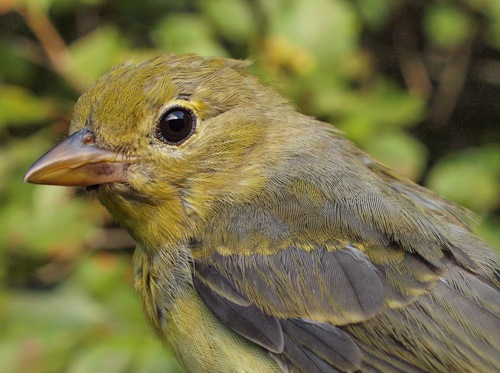 One of the early surprises this week was the juvenile Scarlet Tanager above, a species that more commonly passes through MBO later in August. Meanwhile, the Northern Parula below is likely one of the season’s first moult migrants to arrive at MBO. These two species, along with Indigo Bunting, were all banded this week for the first time in 2013. (Photos by Simon Duval)
One of the early surprises this week was the juvenile Scarlet Tanager above, a species that more commonly passes through MBO later in August. Meanwhile, the Northern Parula below is likely one of the season’s first moult migrants to arrive at MBO. These two species, along with Indigo Bunting, were all banded this week for the first time in 2013. (Photos by Simon Duval)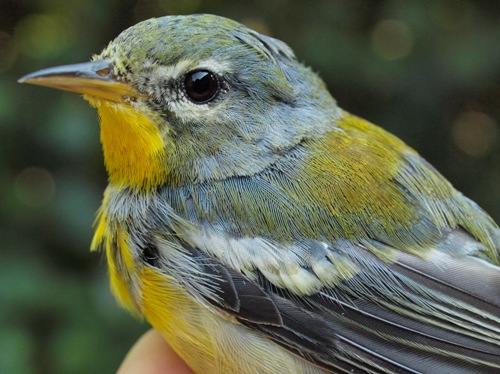
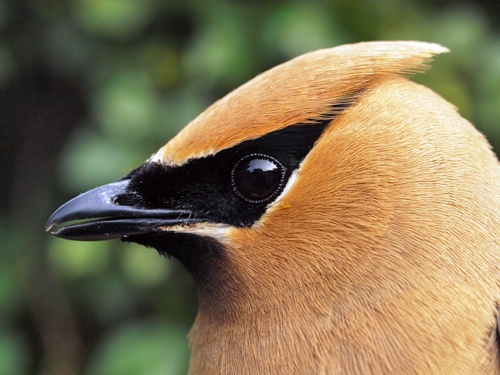 A nice facial profile of one of the 56 Cedar Waxwings banded this week. (Photo by Simon Duval)
A nice facial profile of one of the 56 Cedar Waxwings banded this week. (Photo by Simon Duval)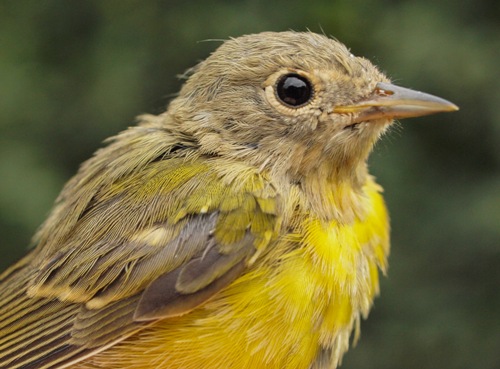 Nashville Warblers usually peak at MBO in September, after arriving from breeding grounds somewhere to the north. This very young-looking juvenile though suggests that at least one pair was breeding nearby this year, perhaps in the adjacent Morgan Arboretum. (Photo by Simon Duval)
Nashville Warblers usually peak at MBO in September, after arriving from breeding grounds somewhere to the north. This very young-looking juvenile though suggests that at least one pair was breeding nearby this year, perhaps in the adjacent Morgan Arboretum. (Photo by Simon Duval)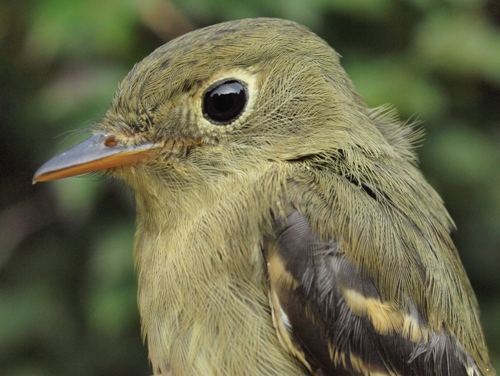 This Yellow-bellied Flycatcher was part of the first significant wave of “truly” boreal migrants that passed through MBO on August 6. (Photo by Simon Duval)
This Yellow-bellied Flycatcher was part of the first significant wave of “truly” boreal migrants that passed through MBO on August 6. (Photo by Simon Duval)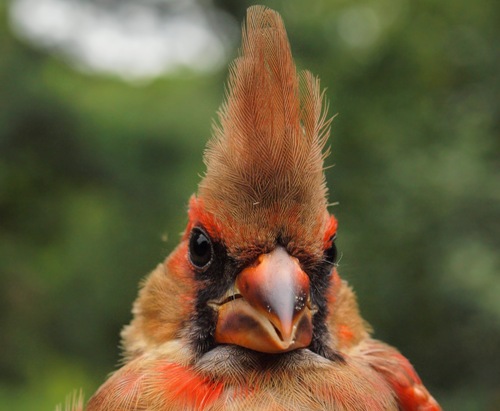 This juvenile male Northern Cardinal is already beginning to acquire some red plumage. (Photo by Simon Duval)
This juvenile male Northern Cardinal is already beginning to acquire some red plumage. (Photo by Simon Duval)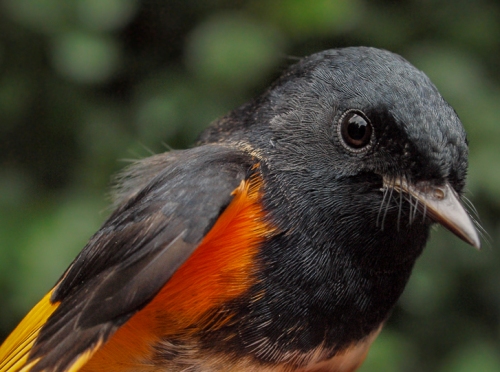 Mid-August is when American Redstarts dominate at MBO, and this year appears to be no exception, with 22 of them banded this week, including the adult male above. (Photo by Simon Duval)
Mid-August is when American Redstarts dominate at MBO, and this year appears to be no exception, with 22 of them banded this week, including the adult male above. (Photo by Simon Duval)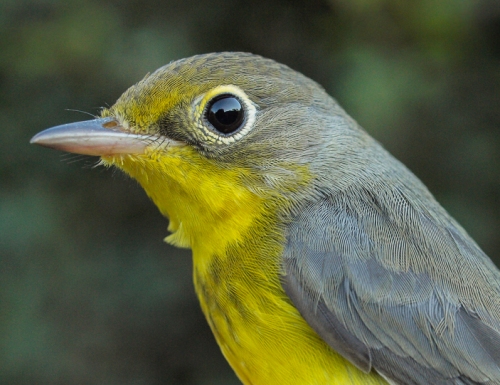 Of the 26 warbler species that have been banded at MBO, two of the less common ones are Canada Warbler (above), and Mourning Warbler (below), both of which peak during fall migration in August. (Photos by Simon Duval)
Of the 26 warbler species that have been banded at MBO, two of the less common ones are Canada Warbler (above), and Mourning Warbler (below), both of which peak during fall migration in August. (Photos by Simon Duval)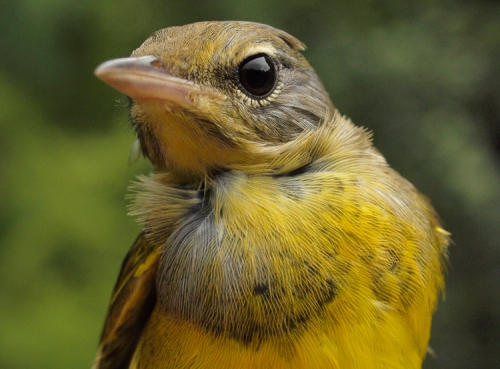
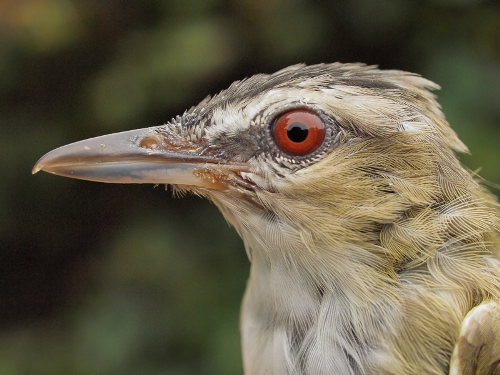 Red-eyed Vireo migration typically peaks at MBO in September, but the species is often already among the top ten species banded as early as mid-August, as was the case this year again in week 2. This adult is currently looking a bit scruffy as it goes through its prebasic moult, but can be aged by the colour of its eye. (Photo by Simon Duval)
Red-eyed Vireo migration typically peaks at MBO in September, but the species is often already among the top ten species banded as early as mid-August, as was the case this year again in week 2. This adult is currently looking a bit scruffy as it goes through its prebasic moult, but can be aged by the colour of its eye. (Photo by Simon Duval)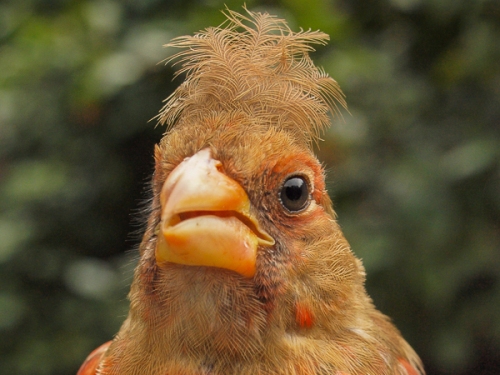 Northern Cardinals are adorable enough at this time of year to be featured two weeks in a row! (Photo by Simon Duval)
Northern Cardinals are adorable enough at this time of year to be featured two weeks in a row! (Photo by Simon Duval)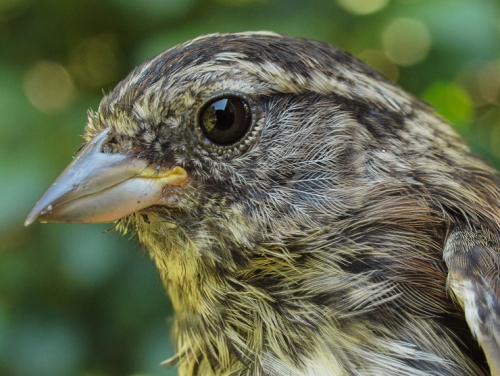 The “fresh crop” of sparrows in August can always be a bit of a challenge as juveniles of many species are dull and heavily streaked. This White-throated Sparrow is quite different from what is shown in most field guides … and rather similar in appearance to juvenile Song Sparrows. (Photo by Simon Duval)
The “fresh crop” of sparrows in August can always be a bit of a challenge as juveniles of many species are dull and heavily streaked. This White-throated Sparrow is quite different from what is shown in most field guides … and rather similar in appearance to juvenile Song Sparrows. (Photo by Simon Duval)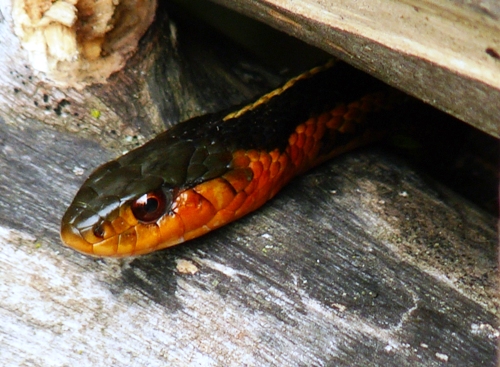 One of our local garter snakes has taken up residence in our wood pile. (Photo by Marcel Gahbauer)
One of our local garter snakes has taken up residence in our wood pile. (Photo by Marcel Gahbauer)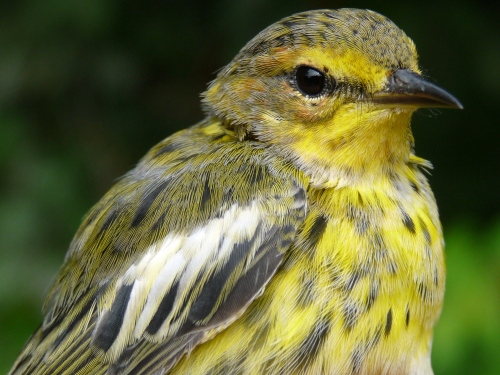 Cape May Warbler is a regular but uncommon migrant at MBO – the three banded this week increased our total over nine years to just 47 individuals. (Photo by Marcel Gahbauer) –
Cape May Warbler is a regular but uncommon migrant at MBO – the three banded this week increased our total over nine years to just 47 individuals. (Photo by Marcel Gahbauer) –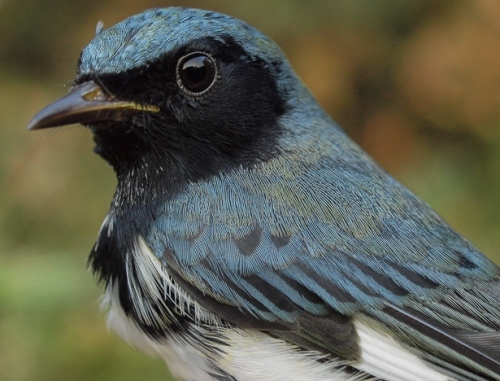 Although Black-throated Blue Warblers usually do not peak until late September, we have already banded four this fall, including the male above (Photo by Simon Duval). Conversely, Traill’s Flycatchers such as the one below are early migrants that we’re unlikely to see at MBO beyond the end of August. This is one of the rare species to undergo its prebasic molt on its wintering grounds, so it is the adults like this one that look scruffy during fall migration (Photo by Marcel Gahbauer)>.
Although Black-throated Blue Warblers usually do not peak until late September, we have already banded four this fall, including the male above (Photo by Simon Duval). Conversely, Traill’s Flycatchers such as the one below are early migrants that we’re unlikely to see at MBO beyond the end of August. This is one of the rare species to undergo its prebasic molt on its wintering grounds, so it is the adults like this one that look scruffy during fall migration (Photo by Marcel Gahbauer)>. 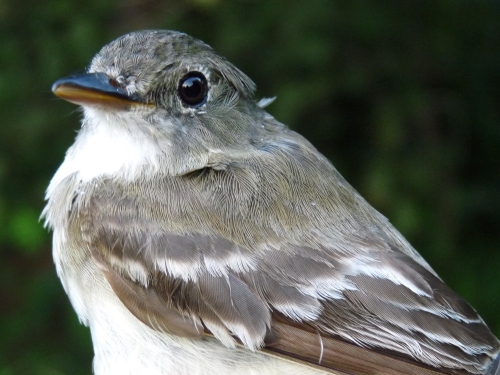
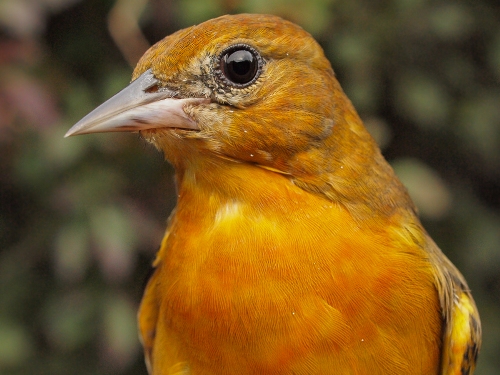 One of the ten Baltimore Orioles banded at MBO this week. (Photo by Simon Duval)
One of the ten Baltimore Orioles banded at MBO this week. (Photo by Simon Duval)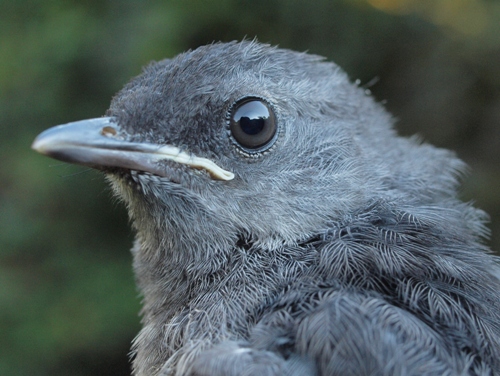 Although we are increasingly seeing migrants by mid-August, there are still a few local youngsters mixed in, like this Gray Catbird. (Photo by Simon Duval)
Although we are increasingly seeing migrants by mid-August, there are still a few local youngsters mixed in, like this Gray Catbird. (Photo by Simon Duval)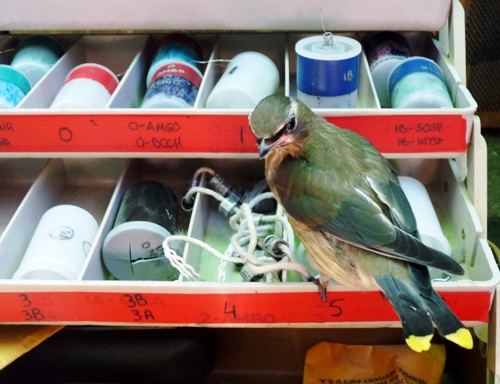 “Which one is for me?” On August 16, Simon Duval and Marcel Gahbauer visited Le Nichoir to band the birds they have been rehabilitating and will soon be ready for release. Among them were more than a dozen juvenile Cedar Waxwings, including this one that chose an unusually direct approach and landed on our banding kit to check out the selection of bands available! (Photo by Marcel Gahbauer)
“Which one is for me?” On August 16, Simon Duval and Marcel Gahbauer visited Le Nichoir to band the birds they have been rehabilitating and will soon be ready for release. Among them were more than a dozen juvenile Cedar Waxwings, including this one that chose an unusually direct approach and landed on our banding kit to check out the selection of bands available! (Photo by Marcel Gahbauer)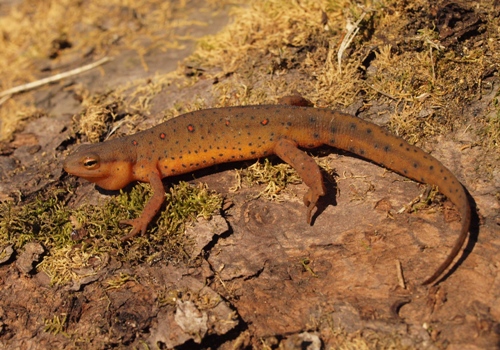 Continuing last week’s theme of closing with a local herptile, here is a red-spotted newt that was wandering around near the banding cabin. (Photo by Simon Duval)
Continuing last week’s theme of closing with a local herptile, here is a red-spotted newt that was wandering around near the banding cabin. (Photo by Simon Duval)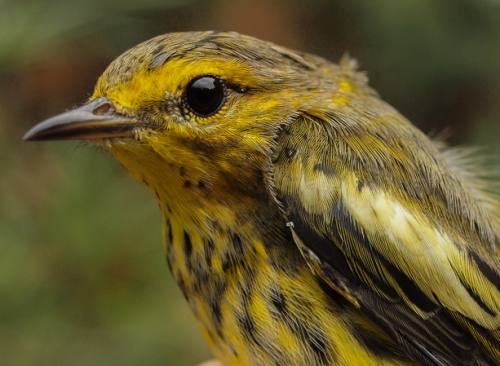 It isn’t often that we feature the same species two weeks in a row. However, the 10 Cape May Warblers banded at MBO was that noteworthy – the previous single-week record was just 6, in the first week of August 2011. (Photo by Simon Duval)
It isn’t often that we feature the same species two weeks in a row. However, the 10 Cape May Warblers banded at MBO was that noteworthy – the previous single-week record was just 6, in the first week of August 2011. (Photo by Simon Duval)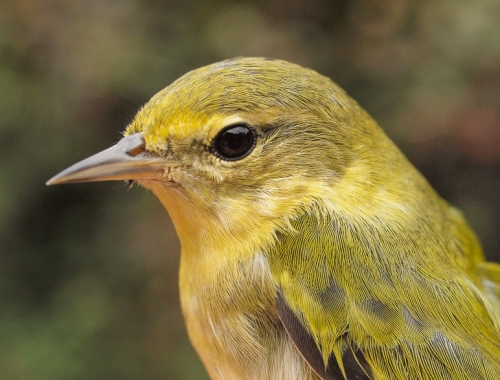 Tennessee Warblers (including the one above) dominated the week, with 73 individuals banded, also a single-week record. The best previously was 52 in week 5 of 2011, so perhaps next week will be even more productive! For comparison, below is a Red-eyed Vireo, occasionally confused with Tennessee Warbler (Photos by Simon Duval).
Tennessee Warblers (including the one above) dominated the week, with 73 individuals banded, also a single-week record. The best previously was 52 in week 5 of 2011, so perhaps next week will be even more productive! For comparison, below is a Red-eyed Vireo, occasionally confused with Tennessee Warbler (Photos by Simon Duval). 
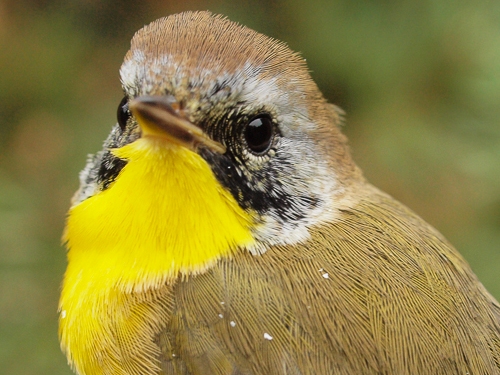 One of the 19 Common Yellowthroats banded at MBO this week. (Photo by Simon Duval)
One of the 19 Common Yellowthroats banded at MBO this week. (Photo by Simon Duval)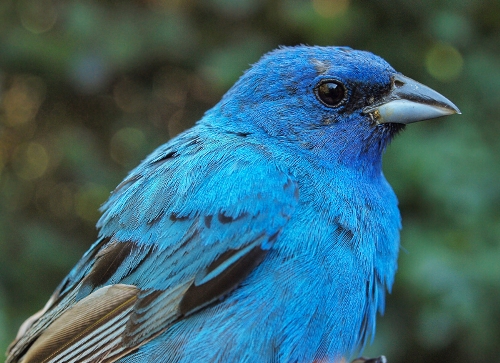 As much as we love the warblers, a bit of variety is always welcome. This adult male was one of 7 Indigo Buntings banded this week, bringing the season total to 18, with the traditional peak of migration yet to come. (Photo by Simon Duval)
As much as we love the warblers, a bit of variety is always welcome. This adult male was one of 7 Indigo Buntings banded this week, bringing the season total to 18, with the traditional peak of migration yet to come. (Photo by Simon Duval) It may be only August, but it’s never too early to prepare for the long winter ahead! Thanks to Malcolm Johnson for building a couple of new wood sheds for us, and to various volunteers for spending time chopping and stacking wood. (Photo by Marcel Gahbauer)
It may be only August, but it’s never too early to prepare for the long winter ahead! Thanks to Malcolm Johnson for building a couple of new wood sheds for us, and to various volunteers for spending time chopping and stacking wood. (Photo by Marcel Gahbauer)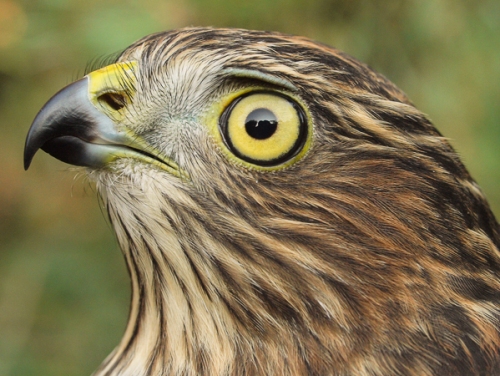 We finally banded our first Sharp-shinned Hawk of 2013 this week. (Photo by Simon Duval)
We finally banded our first Sharp-shinned Hawk of 2013 this week. (Photo by Simon Duval)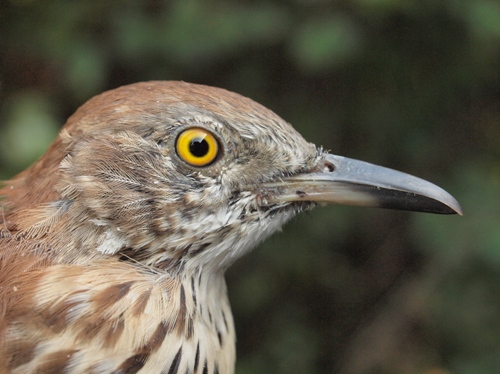 This Brown Thrasher was a return, probably a summer resident at MBO, but not captured earlier in the breeding season. (Photo by Simon Duval)
This Brown Thrasher was a return, probably a summer resident at MBO, but not captured earlier in the breeding season. (Photo by Simon Duval) Tennessee Warblers have been dominant the past couple of weeks, but even so there are surprises, such as this one that appears to be entirely in juvenile plumage. (Photo by Simon Duval)
Tennessee Warblers have been dominant the past couple of weeks, but even so there are surprises, such as this one that appears to be entirely in juvenile plumage. (Photo by Simon Duval) Wlson’s Warbler usually peaks at MBO in the first half of September; to date only 8 individuals have been banded this fall, including the after-hatch-year male above, but the main migration is likely to come next week. (Photo by Simon Duval)
Wlson’s Warbler usually peaks at MBO in the first half of September; to date only 8 individuals have been banded this fall, including the after-hatch-year male above, but the main migration is likely to come next week. (Photo by Simon Duval)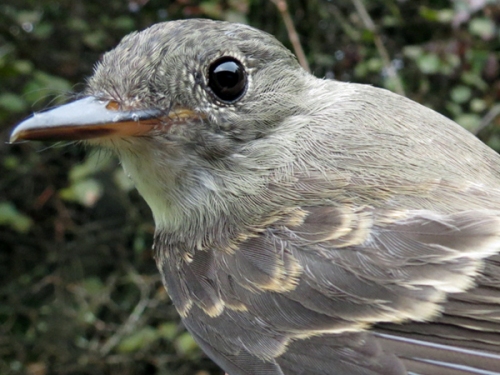 This Eastern Wood-Pewee banded this week was the first since 2009, and only the 8th overall in MBO’s 9 years of operation. (Photo by Gay Gruner)
This Eastern Wood-Pewee banded this week was the first since 2009, and only the 8th overall in MBO’s 9 years of operation. (Photo by Gay Gruner)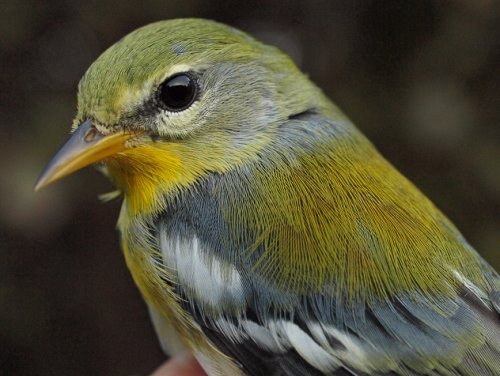 This was just our second Northern Parula of fall 2013. (Photo by Simon Duval)
This was just our second Northern Parula of fall 2013. (Photo by Simon Duval)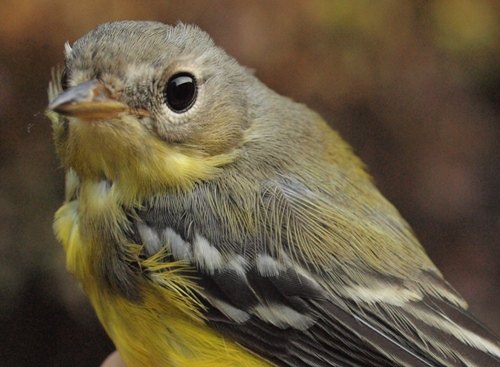 Magnolia Warblers accounted for nearly one-third of birds banded at MBO this week. (Photo by Simon Duval)
Magnolia Warblers accounted for nearly one-third of birds banded at MBO this week. (Photo by Simon Duval)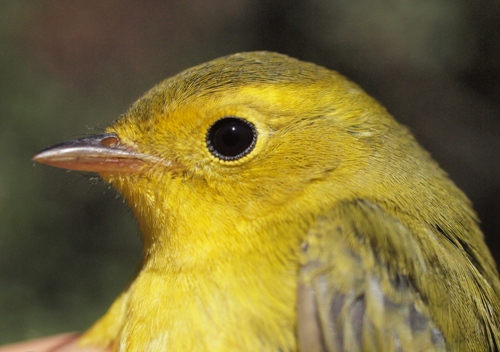 Wilson’s Warblers increased this week; compare this green-capped hatch-year female with the black-capped after-hatch-year male in last week’s report. (Photo by Simon Duval)
Wilson’s Warblers increased this week; compare this green-capped hatch-year female with the black-capped after-hatch-year male in last week’s report. (Photo by Simon Duval)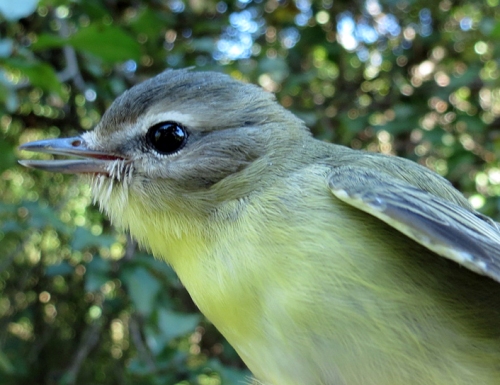 Philadelphia Vireo is always an uncommon migrant at MBO – this was just the second individual banded this fall. (Photo by Gay Gruner)
Philadelphia Vireo is always an uncommon migrant at MBO – this was just the second individual banded this fall. (Photo by Gay Gruner)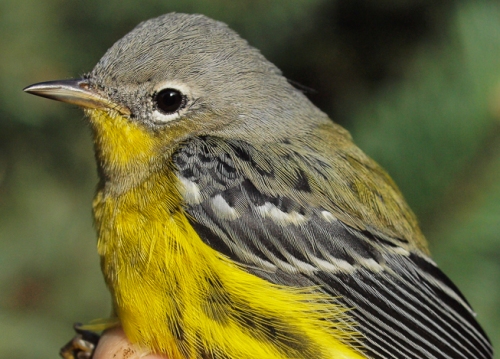 There was no doubt that this was the week of Magnolia Warblers, with 84 of them banded, including this after-hatch-year male. (Photo by Simon Duval)
There was no doubt that this was the week of Magnolia Warblers, with 84 of them banded, including this after-hatch-year male. (Photo by Simon Duval)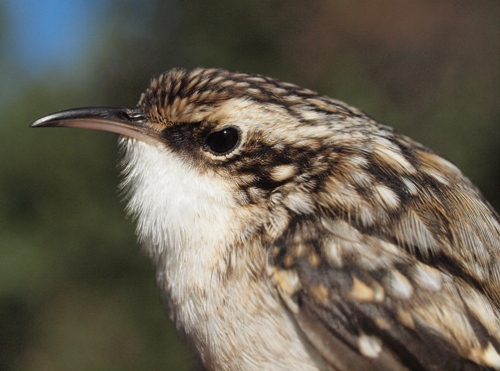 Brown Creepers and Golden-crowned Kinglets banded this week were signs of the advancing fall, with both being more typical of the second half of the season at MBO. The four Golden-crowned Kinglets caught at the same time was remarkable given that in most years none at all have been banded this early in fall. (Photos by Simon Duval)
Brown Creepers and Golden-crowned Kinglets banded this week were signs of the advancing fall, with both being more typical of the second half of the season at MBO. The four Golden-crowned Kinglets caught at the same time was remarkable given that in most years none at all have been banded this early in fall. (Photos by Simon Duval)
 Thanks to Jean Demers, Alison Hackney, Ana Morales, Clémence Soulard, and Yifu Wang for sharing MBO with the public at Ste-Anne-de-Bellevue’s annual Ecology Day on September 15. (Photo by Jean Demers)
Thanks to Jean Demers, Alison Hackney, Ana Morales, Clémence Soulard, and Yifu Wang for sharing MBO with the public at Ste-Anne-de-Bellevue’s annual Ecology Day on September 15. (Photo by Jean Demers)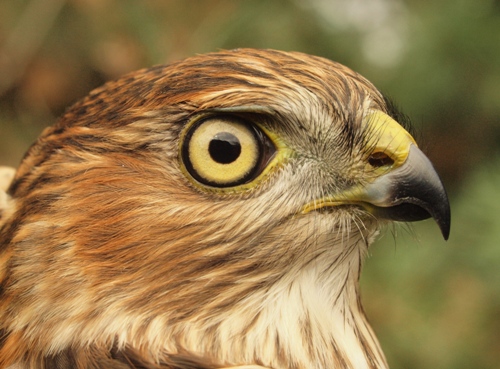 One of the two Sharp-shinned Hawks banded this week. (Photo by Simon Duval)
One of the two Sharp-shinned Hawks banded this week. (Photo by Simon Duval)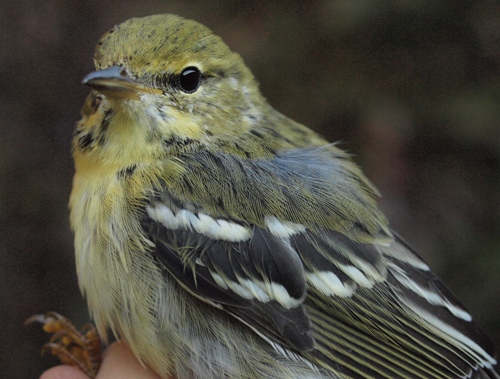 One of the less striking warblers in fall, Blackpoll Warblers can cause some identification challenges, but the orange feet are a good clue. (Photo by Gay Gruner)
One of the less striking warblers in fall, Blackpoll Warblers can cause some identification challenges, but the orange feet are a good clue. (Photo by Gay Gruner)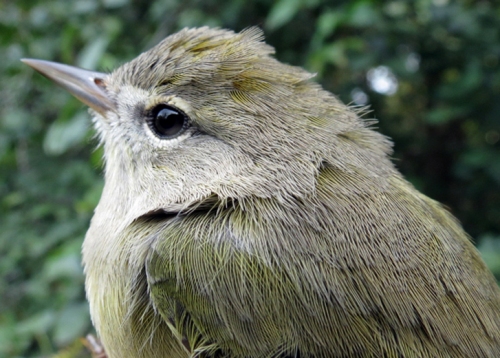 Another relatively drab fall warbler is this Orange-crowned Warbler (with just a hint of orange visible in this case). (Photo by Gay Gruner)
Another relatively drab fall warbler is this Orange-crowned Warbler (with just a hint of orange visible in this case). (Photo by Gay Gruner)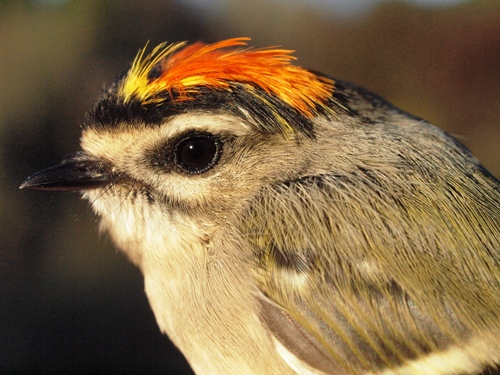 It’s late September at MBO, and right on schedule the kinglets have started to arrive, including this adorable male Golden-crowned Kinglet. (Photo by Simon Duval)
It’s late September at MBO, and right on schedule the kinglets have started to arrive, including this adorable male Golden-crowned Kinglet. (Photo by Simon Duval)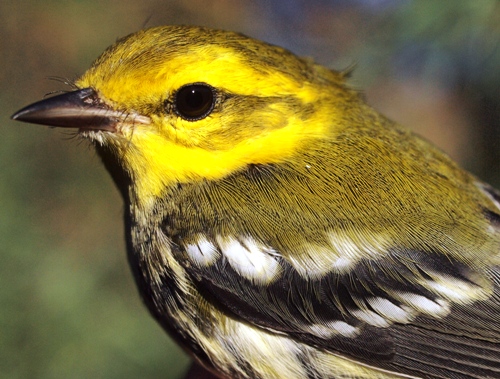 Past mid-September, warbler diversity starts to decline, but the “black-throated” species (green above, blue below) are among the ones still regularly observed at MBO. (Photos by Simon Duval)
Past mid-September, warbler diversity starts to decline, but the “black-throated” species (green above, blue below) are among the ones still regularly observed at MBO. (Photos by Simon Duval)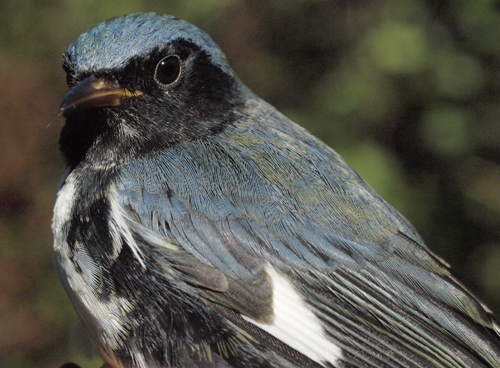
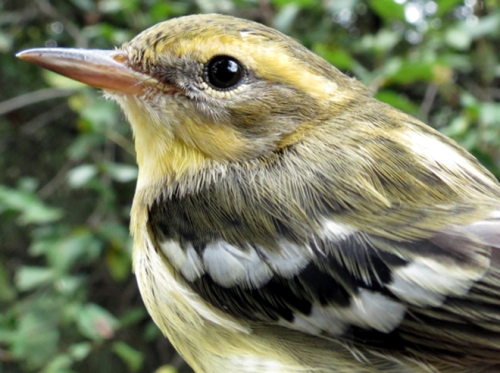 Although three Blackburnian Warblers were observed earlier in fall, this one was the first one to be banded at MBO this season. (Photo by Gay Gruner)
Although three Blackburnian Warblers were observed earlier in fall, this one was the first one to be banded at MBO this season. (Photo by Gay Gruner)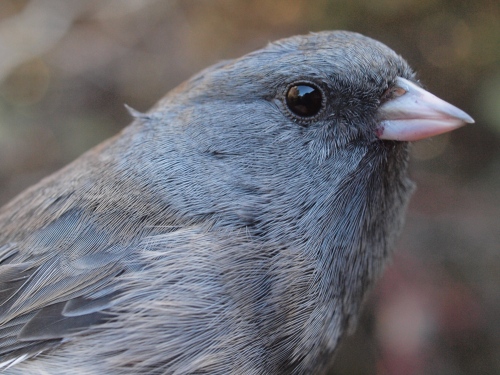 A sure sign that we have turned the corner into late fall, with the first Slate-colored Junco of the season observed and banded. (Photo by Simon Duval)
A sure sign that we have turned the corner into late fall, with the first Slate-colored Junco of the season observed and banded. (Photo by Simon Duval)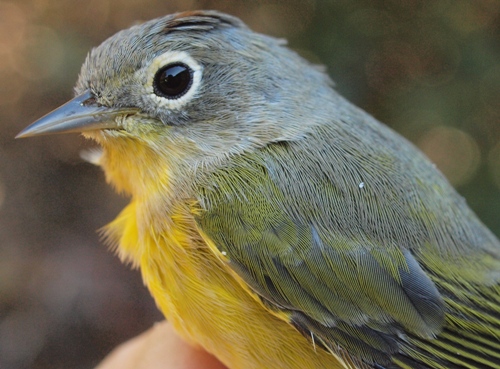 Despite a decent number of Nashville Warblers this week, the season total of 41 banded to date is still fewer than in any previous fall. However, given that we usually continue to band them into November, the previous low of 50 in 2007 will likely be surpassed. (Photo by Simon Duval)
Despite a decent number of Nashville Warblers this week, the season total of 41 banded to date is still fewer than in any previous fall. However, given that we usually continue to band them into November, the previous low of 50 in 2007 will likely be surpassed. (Photo by Simon Duval)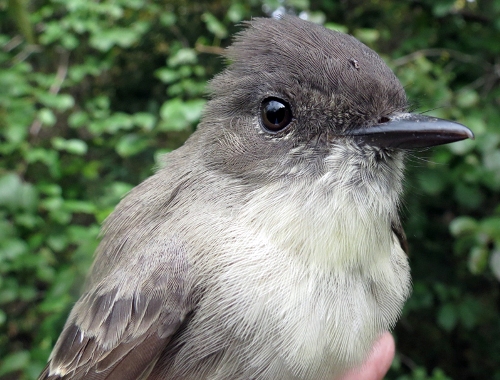 This was the eighth Eastern Phoebe banded at MBO this fall, tying the single-season record set in fall 2008. (Photo by Gay Gruner) –
This was the eighth Eastern Phoebe banded at MBO this fall, tying the single-season record set in fall 2008. (Photo by Gay Gruner) –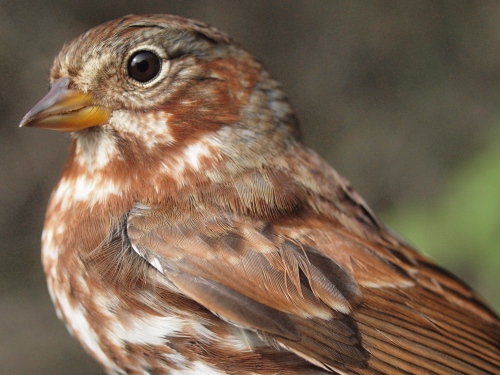 Fox Sparrows have started to move in, with these two banded over the past week. (Photo aboveby Simon Duval; close-up below by Gay Gruner)
Fox Sparrows have started to move in, with these two banded over the past week. (Photo aboveby Simon Duval; close-up below by Gay Gruner)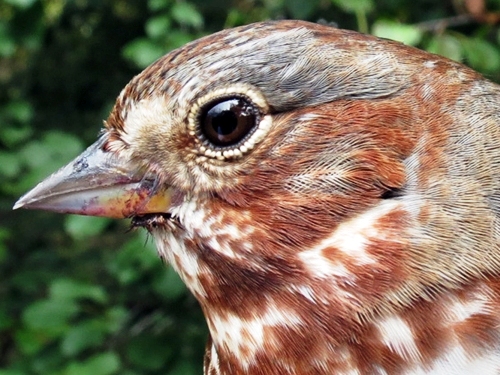
 By late September, warbler diversity is decreasing – but we still managed this nice mix one morning. From left to right: Tennessee Warbler, Cape May Warbler, Nashville Warbler, Orange-crowned Warbler, and an impostor (Ruby-crowned Kinglet). (Photo by Simon Duval)
By late September, warbler diversity is decreasing – but we still managed this nice mix one morning. From left to right: Tennessee Warbler, Cape May Warbler, Nashville Warbler, Orange-crowned Warbler, and an impostor (Ruby-crowned Kinglet). (Photo by Simon Duval)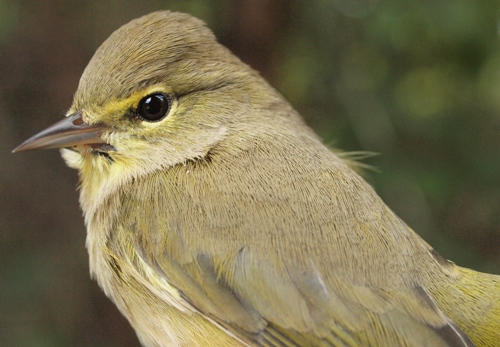 One of the less common warblers at MBO, this was just the fifth Orange-crowned Warbler of the fall. (Photo by Simon Duval)
One of the less common warblers at MBO, this was just the fifth Orange-crowned Warbler of the fall. (Photo by Simon Duval)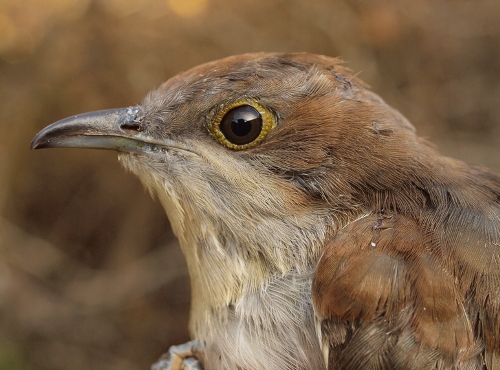 Last week we featured the eighth Eastern Phoebe banded at MBO this fall; this week we have the eighth Black-billed Cuckoo over MBO’s entire history! (Photo by Simon Duval)
Last week we featured the eighth Eastern Phoebe banded at MBO this fall; this week we have the eighth Black-billed Cuckoo over MBO’s entire history! (Photo by Simon Duval)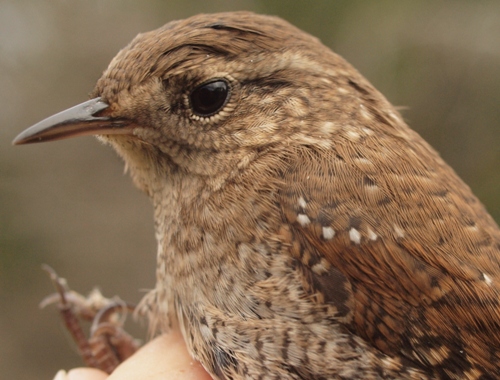 MBO’s first Winter Wren banded this season. (Photo by Simon Duval)
MBO’s first Winter Wren banded this season. (Photo by Simon Duval)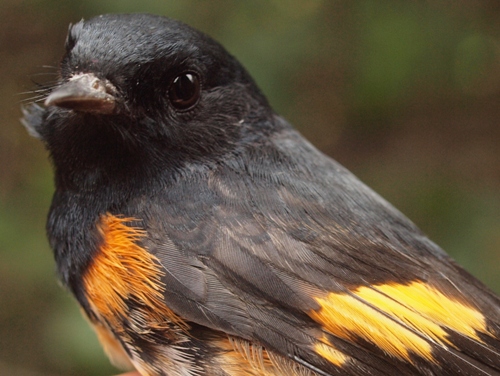 We almost always have an American Redstart or two still passing through MBO in October; this year it was a striking after-hatch-year male. (Photo by Simon Duval)
We almost always have an American Redstart or two still passing through MBO in October; this year it was a striking after-hatch-year male. (Photo by Simon Duval)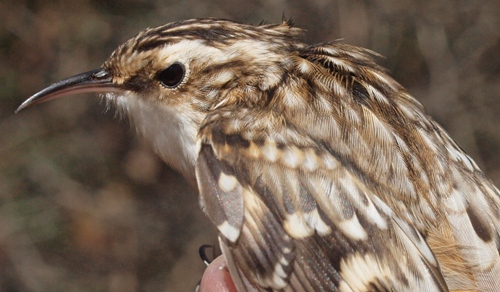 Brown Creeper, another one of our reliable October birds at MBO. (Photo by Simon Duval)
Brown Creeper, another one of our reliable October birds at MBO. (Photo by Simon Duval)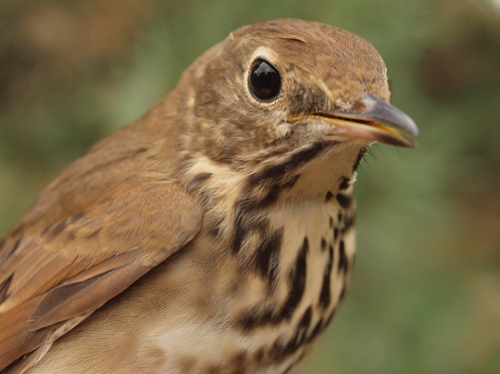 Continuing with brown October birds, one of this week’s several Hermit Thrushes. (Photo by Simon Duval)
Continuing with brown October birds, one of this week’s several Hermit Thrushes. (Photo by Simon Duval)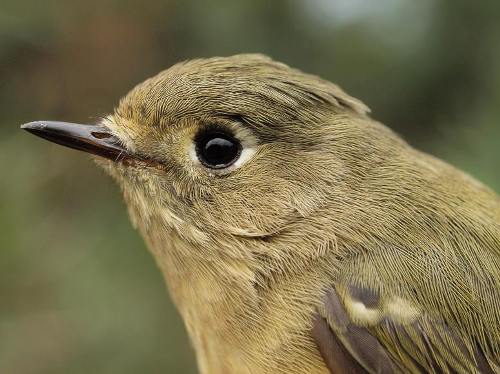 It was a kinglet week at MBO, with this and 60 other Ruby-crowned as well as 31 Golden-crowned banded, plus many more observed. (Photo by Simon Duval)
It was a kinglet week at MBO, with this and 60 other Ruby-crowned as well as 31 Golden-crowned banded, plus many more observed. (Photo by Simon Duval)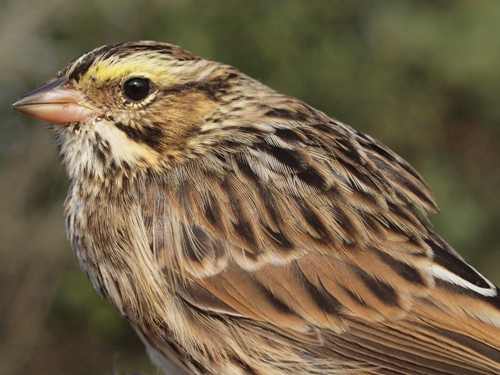 The first Savannah Sparrow banded at MBO in fall since 2008. (Photo by Simon Duval)
The first Savannah Sparrow banded at MBO in fall since 2008. (Photo by Simon Duval)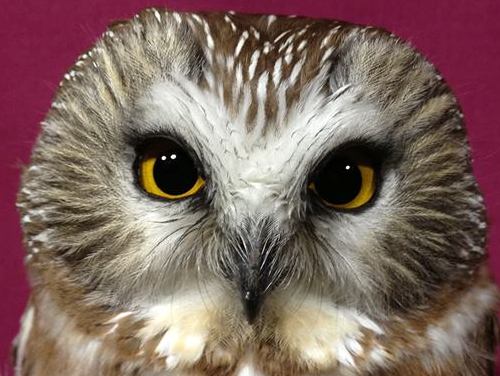 We banded this Northern Saw-whet Owl last week on October 9; only three days later it was recaptured at a banding station in the Adirondacks, 110 km to the south! (Photo by Nicolas Bernier)
We banded this Northern Saw-whet Owl last week on October 9; only three days later it was recaptured at a banding station in the Adirondacks, 110 km to the south! (Photo by Nicolas Bernier) Morning light at MBO. (Photo by Simon Duval)
Morning light at MBO. (Photo by Simon Duval)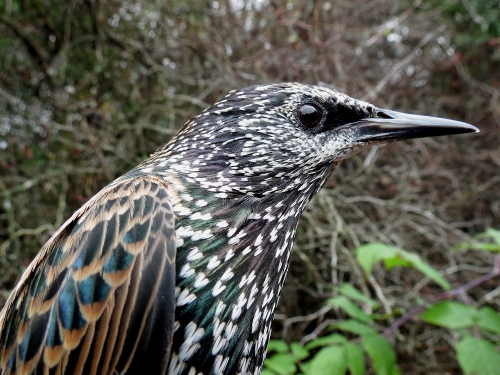 Although an abundant bird, European Starling is rarely banded at MBO – this one was only the fourth ever during the fall season. (Photo by Gay Gruner)
Although an abundant bird, European Starling is rarely banded at MBO – this one was only the fourth ever during the fall season. (Photo by Gay Gruner)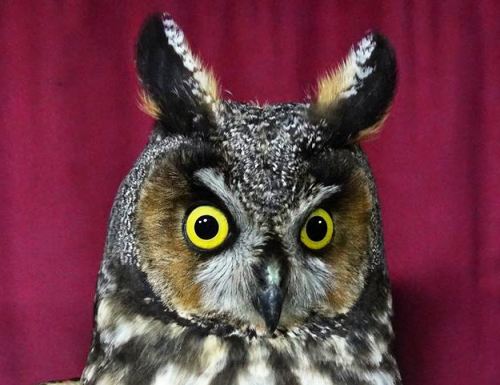 The first Long-eared Owl banded at MBO this fall, and just the third ever. (Photo by Nicolas Bernier) –
The first Long-eared Owl banded at MBO this fall, and just the third ever. (Photo by Nicolas Bernier) –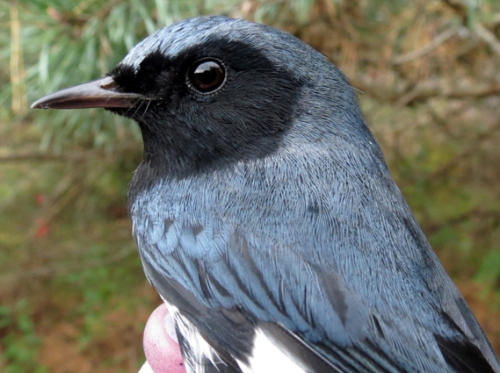 By mid-October, warblers at MBO are largely limited to Yellow-rumped, but the occasoinal late Black-throated Blue can be found too. (Photo by Gay Gruner)
By mid-October, warblers at MBO are largely limited to Yellow-rumped, but the occasoinal late Black-throated Blue can be found too. (Photo by Gay Gruner)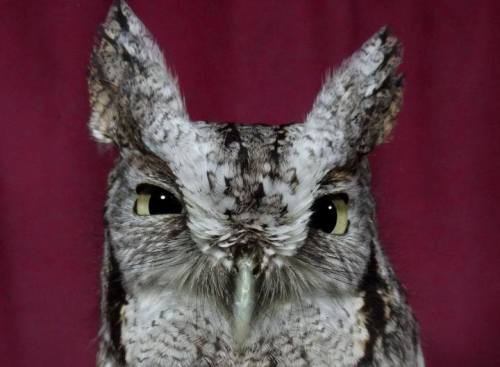 This is the first Eastern Screech-Owl we have recaptured at MBO – we banded it as a hatch-year individual last fall. (Photo by Nicolas Bernier)
This is the first Eastern Screech-Owl we have recaptured at MBO – we banded it as a hatch-year individual last fall. (Photo by Nicolas Bernier)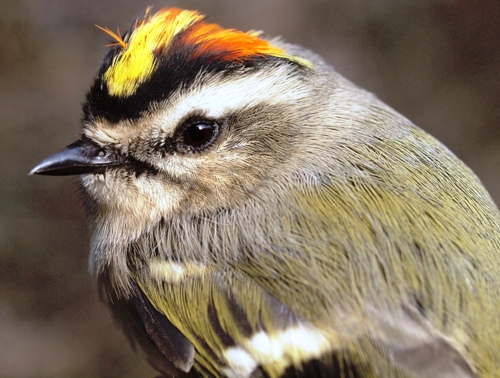 Golden-crowned Kinglets have been more numerous at MBO this fall than ever before, with over 100 banded so far. (Photo by Simon Duval)
Golden-crowned Kinglets have been more numerous at MBO this fall than ever before, with over 100 banded so far. (Photo by Simon Duval)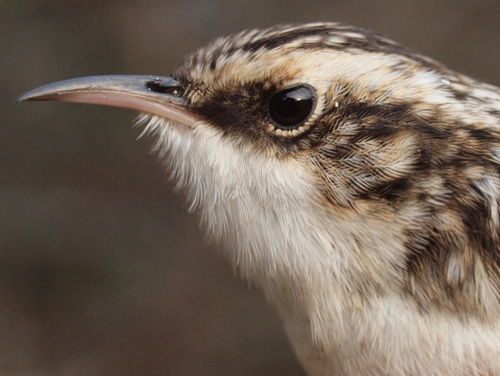 Brown Creepers and Golden-crowned Kinglets often favour similar habitat, so it seems appropriate to post their photos together too! (Photo by Simon Duval)
Brown Creepers and Golden-crowned Kinglets often favour similar habitat, so it seems appropriate to post their photos together too! (Photo by Simon Duval)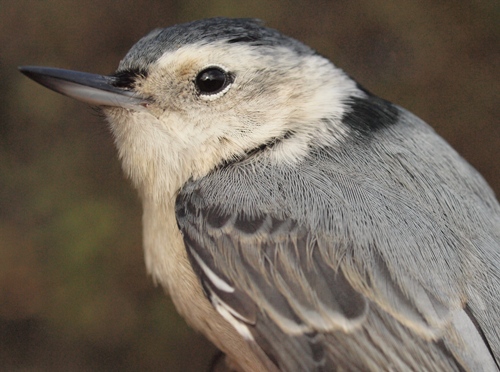 A female White-breasted Nuthatch, a nice way to wrap up the fall 2013 season. (Photo by Simon Duval) –
A female White-breasted Nuthatch, a nice way to wrap up the fall 2013 season. (Photo by Simon Duval) – This year’s final-week-of-fall Northern Shrike, almost an annual occurrence at MBO. (Photo by Lisa Keelty)
This year’s final-week-of-fall Northern Shrike, almost an annual occurrence at MBO. (Photo by Lisa Keelty) Although many saw-whet banders in eastern North America have been disappointed with numbers this fall, it has been a good season at MBO, with 160 banded to date. (Photo by Nicolas Bernier)
Although many saw-whet banders in eastern North America have been disappointed with numbers this fall, it has been a good season at MBO, with 160 banded to date. (Photo by Nicolas Bernier)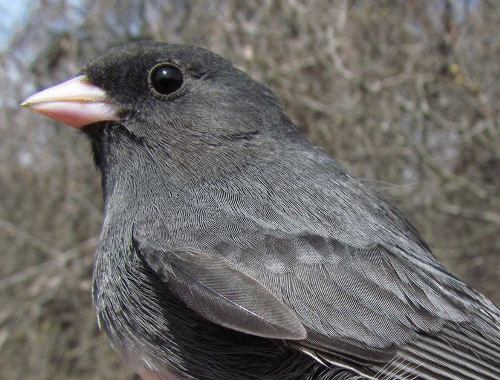 Like 2006 and 2011, it was a quiet fall for Slate-colored Juncos at MBO, with only 60 banded (compared to a fall mean of 214) and only small flocks observed. (Photo by Lisa Keelty)
Like 2006 and 2011, it was a quiet fall for Slate-colored Juncos at MBO, with only 60 banded (compared to a fall mean of 214) and only small flocks observed. (Photo by Lisa Keelty)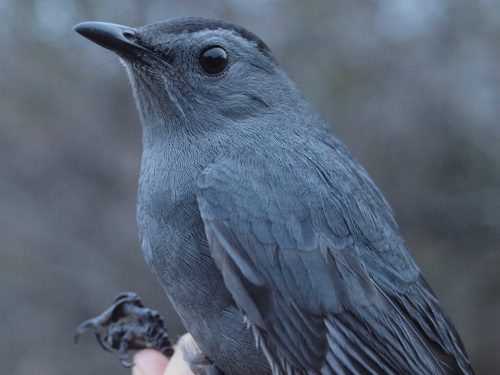 Finishing out the season with a surprise, this Gray Catbird banded on our final morning of banding (Oct 30) was the latest ever fall observation of the species at MBO. (Photo by Simon Duval)
Finishing out the season with a surprise, this Gray Catbird banded on our final morning of banding (Oct 30) was the latest ever fall observation of the species at MBO. (Photo by Simon Duval)